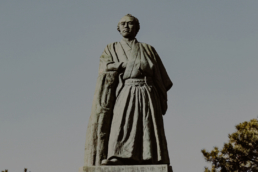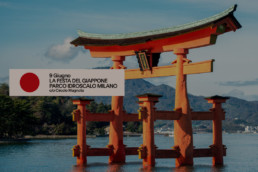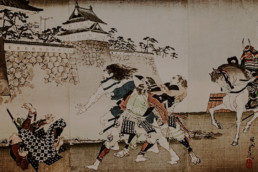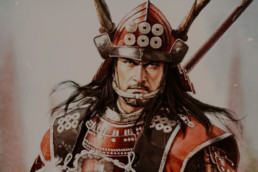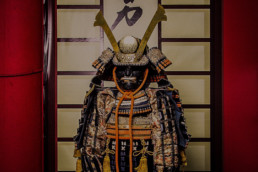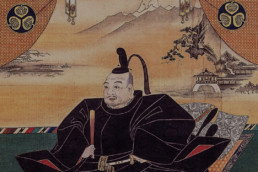Discovering the wonders of Okinawa
The Okinawa Islands form the main group of the Japanese Ryūkyū archipelago. They include the homonymous island together with other minor ones and are part of the Okinawa prefecture whose capital is Naha.
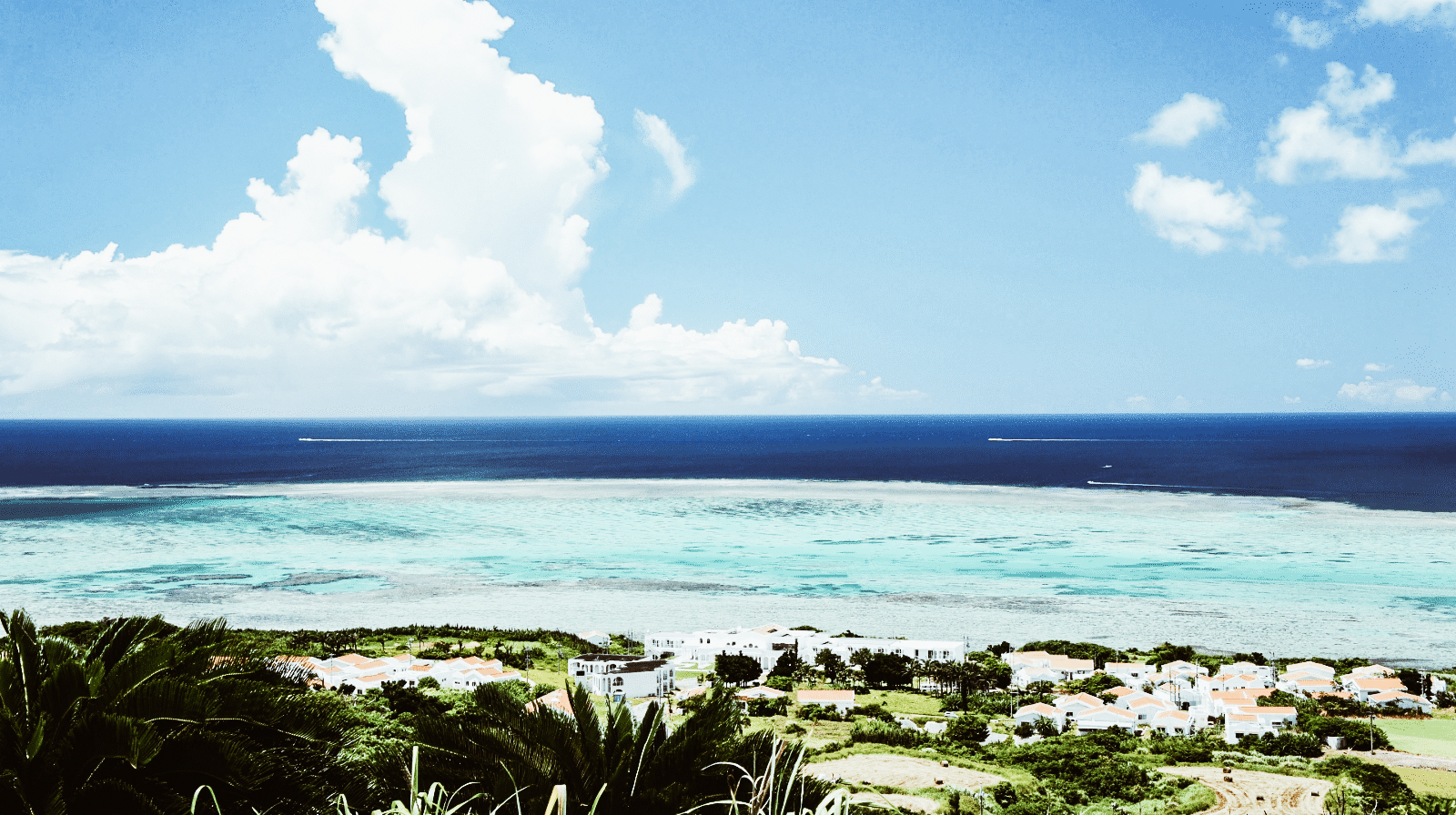
photo credits: jw-webmagazine.com
The famous martial art of karate comes from Okinawa. This is an art created following the fusion of Chinese martial arts with the Okinawa-te (then subdivided into Naha-te, Shuri-te and Tomari-te).
Also, the island of Okinawa is the largest in the archipelago and is the 287th largest island in the world. The subtropical climate of these islands supports a dense rainforest, maintained by the monsoon season that occurs in late spring.
Okinawa has many landmarks, perhaps too many. It is a destination that cannot be missed in our Japanese travel itinerary. Here we wanted to collect what we think are the best locations to visit. However, our advice is to dedicate as much time as possible to this islands, also called Japanese Polynesia.
Shuri Castle
Shuri was the ancient capital of the Ryukyu kingdom and the castle was the administrative centre and residence of the royal family. Shuri Castle (Shuri-jo) is located on a small hill overlooking Naha. The original structure was destroyed during the Second World War and later rebuilt. The area was reopened to the public in 1992 on the occasion of the 20th anniversary of the return of Okinawa to Japan by the USA.
Today the castle is part of the UNESCO World Heritage Site.
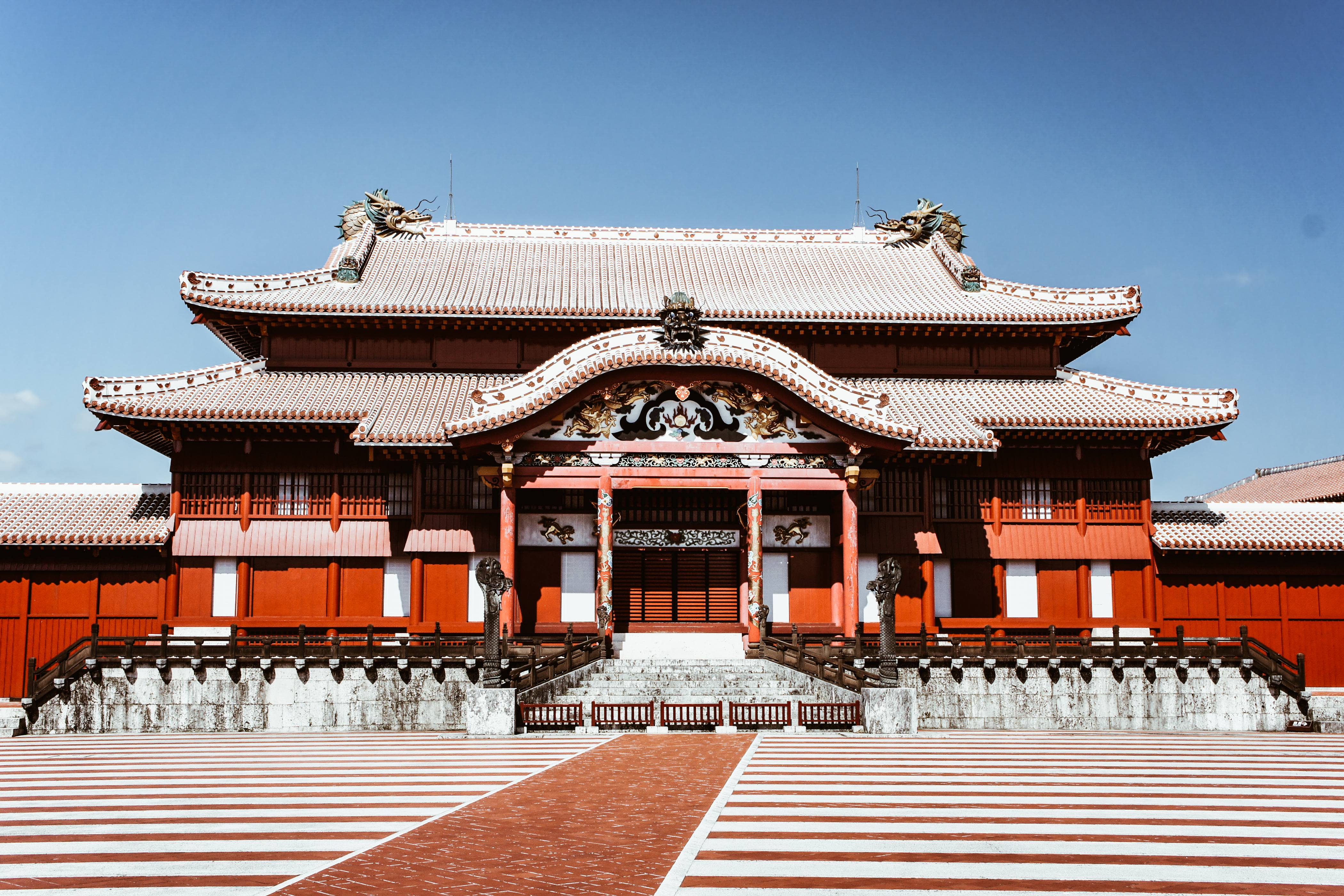
photo credits: wikipedia.org
Seminational park of Okinawa Senseki
This is the place where the famous battle of Okinawa took place during the Second World War, the park is dedicated to the approximately 200,000 victims of the conflicts. Of particular importance are the Memorial Museum of Peace with several pieces that refer to the war. We remember in fact the objects of the fallen, their photos during the war of Okinawa and the Cornerstone of Peace with all the names of the fallen. On June 23 in 1945 the Japanese army stopped resisting. This is the day on which the commemorative ceremony for the war dead is held every year.
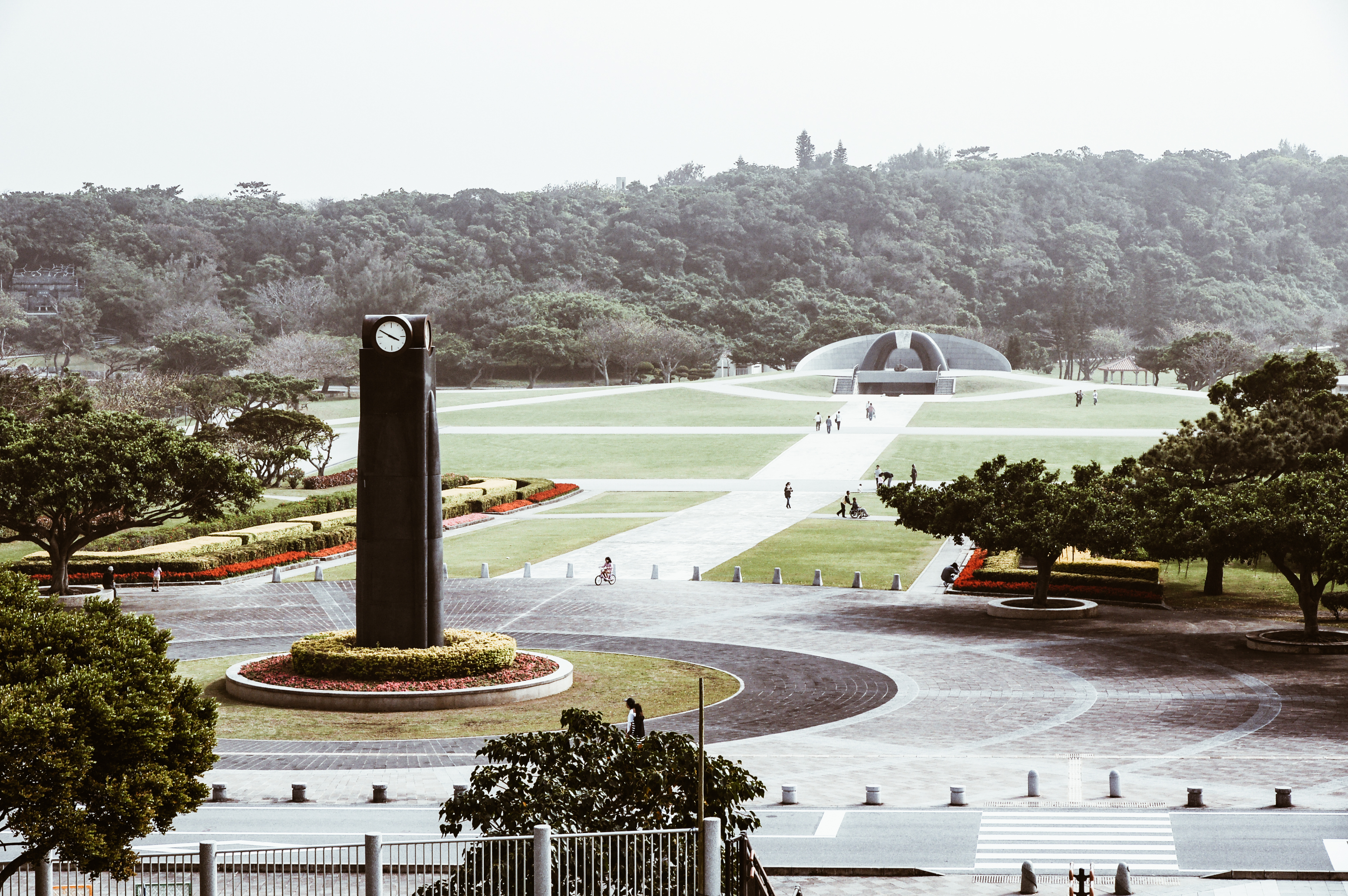
photo credits: wikipedia.org
Sefa Utaki
Sefa Utaki is an important sacred place for Okinawan religion located on Kudaka Island. It is located on a hill with rock formations connected by pedestrian paths. The English translation of the word Sefa-utaki is "purified place of Utaki". This site is also part of the UNESCO World Heritage.

photo credits: japan-guide.com
Shikinaen Garden
The Shikinaen garden was built at the end of the 18th century and was the second residence of the kings of Ryukyu. Here you can find wooden buildings in Okinawan style, with red tiles and a central pond.

photo credits: giapponepertutti.it
Tamaudun Mausoleum
The Tamaudun mausoleum was built around the beginning of the 16th century for the royal family of the Ryukyu Kingdom. It was restored after suffering serious damage during the war and is now a UNESCO World Heritage Site.

photo credits: sobre-japon.com
Ocean Expo Park
The Ocean Expo Park is a large park on the tip of the Motobu peninsula, in the north of Okinawa Honto. This attraction was built in 1976 to commemorate the Okinawa International Ocean Expo held the previous year. The main attraction of the park is the Churaumi Aquarium, called the most beautiful aquarium in Japan.
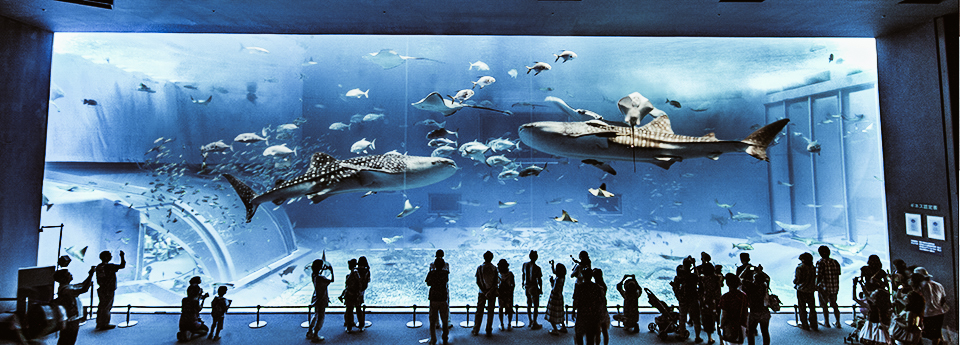
photo credits: worldsciencemuseums.altervista.org
Kokusai Dori
Kokusaidori (literally "International Road") is the main road that extends for about two kilometres through the centre of Naha. The street is named after the previous "Ernie Pyle International Theater", a cinema built along the road after the war.

photo credits: japan-guide.com
Hiji waterfall
The Hiji waterfall is located in Yambaru Honto, in the northern part of Okinawa. Here the population density is very low and most of the territory is covered by natural forests. The waterfall can be accessed via a hike along a path through the forest. However, the trail was damaged by a typhoon in 2012 but reopened in April 2013.
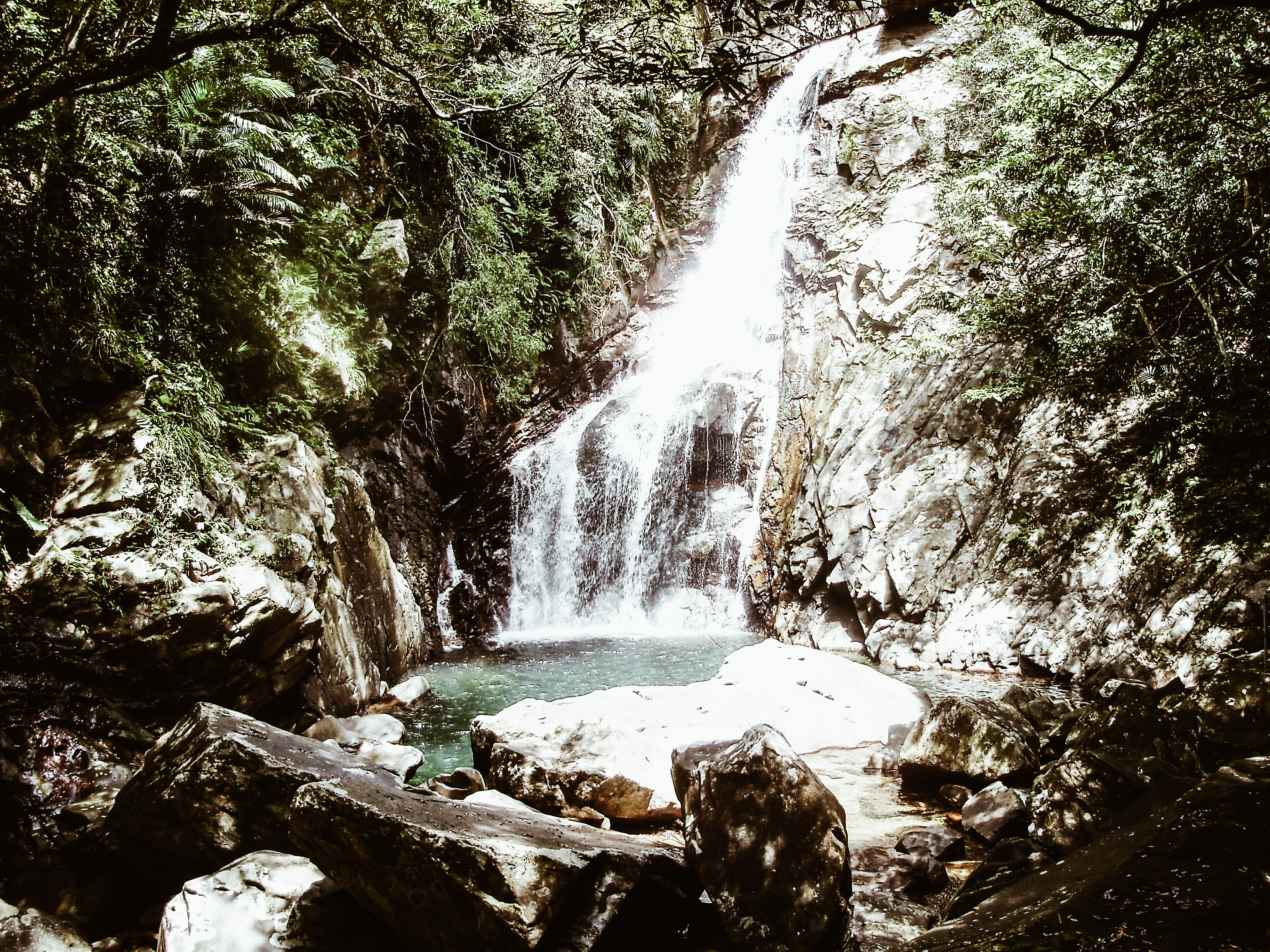
photo credits: ilgiappone.wordpress.com
Ruins of the Nakagusuku, Katsuren and Zakimi castles
Another very interesting destination is the ruins of the Castles of Nakagusuku, Katsuren and Zakimi of which these last two are UNESCO heritage.
The first stands 150 meters above sea level and was originally built by the Aji clan in the 14th century. Later, Gosamaru extended it in the 15th century before finally falling into the hands of Awamari-san. This castle today is part of the UMA.

photo credits: travel.sygic.com
Katsuren Castle, on the other hand, was owned by Awamari-san. In the fifteenth century, he put real power in serious difficulty because of his rebellious character and his military conquests.
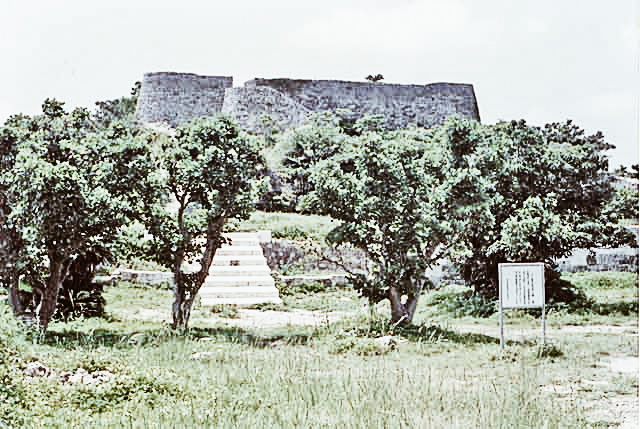
photo credits: it.depositphotos.com
Zakimi Castle was built in the fifteenth century by the legendary warrior Gosamaru. Known for its military constructions, this castle is the first example of a stone portal existing on the island of Okinawa.
Mihama American Village
The Mihama American Village is a large entertainment complex located in the centre of Okinawa Honto. Many American military bases are in the area and the entertainment complex is a much sought after diversion for the locals. The Mihama American Village has many shops, restaurants, cafes and ample parking.

photo credits: en.japantravel.com
Okinawa World
Okinawa World is a park dedicated to Okinawan culture. The main attractions of the park are a large natural cave (Gyokusendo), a craft village and a snake museum.

photo credits: city-cost.com
Let's move on to nature because it is true that Okinawa is tradition and history, but it is also a natural paradise to live. There are many dream beaches where you can spend unforgettable moments, but for you, we have chosen the best ones. Tell us what you think of our selection!
The beaches of Okinawa: Manza Beach
The soft sand beach is part of the ANA InterContinental Manza Beach Resort, whose building overlooks the 300 meters of the beach.

photo credits: okinawatravelinfo.com
The beaches of Okinawa: Moon Beach
Moon Beach is a beach located within the grounds of Hotel Moon Beach. The beach stretches for 150 meters and is often very crowded. There is an area reserved for swimmers, umbrellas and volleyball nets.
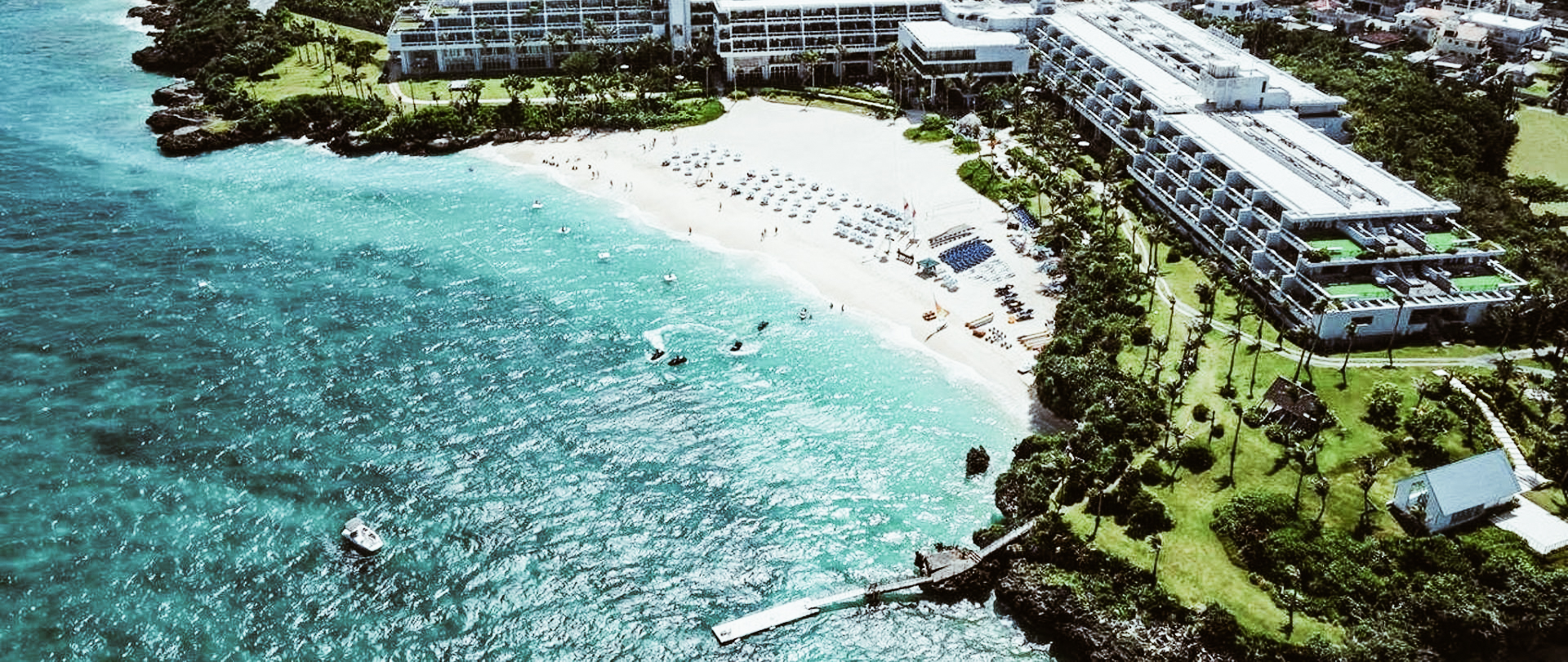
photo credits: hotelmoonbeach.moonhotelsandresorts.com
The beaches of Okinawa: Sunset Beach
Do you want to enjoy sunsets? Then you can't miss Sunset Beach. It is located right next to the Mihama American Village. The beach is about 250 meters long and is located in a small artificial bay on the western shore.
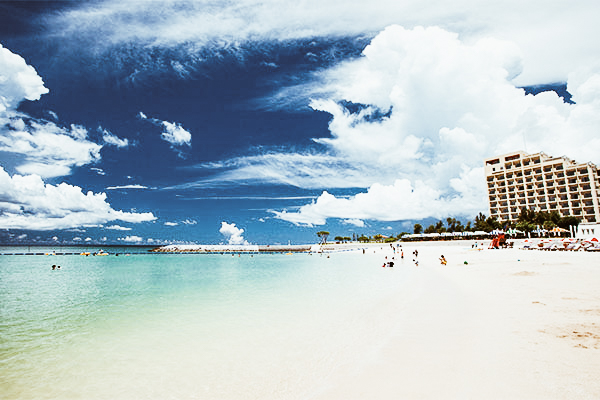
photo credits: oki-islandguide.com
The beaches of Okinawa: Emerald Beach
Emerald Beach is located within the Ocean Expo Park on the Motobu peninsula. The beach is divided into three sectors and each of the three areas is about 150 meters long.

photo credits: okinawatravelinfo.com
The beaches of Okinawa: Okuma Beach
Okuma Beach is a beach located within the JAL Private Resort Okuma. It is located in the north of Okinawa Honto, the least densely populated area. The beach stretches over a kilometre along the coast.
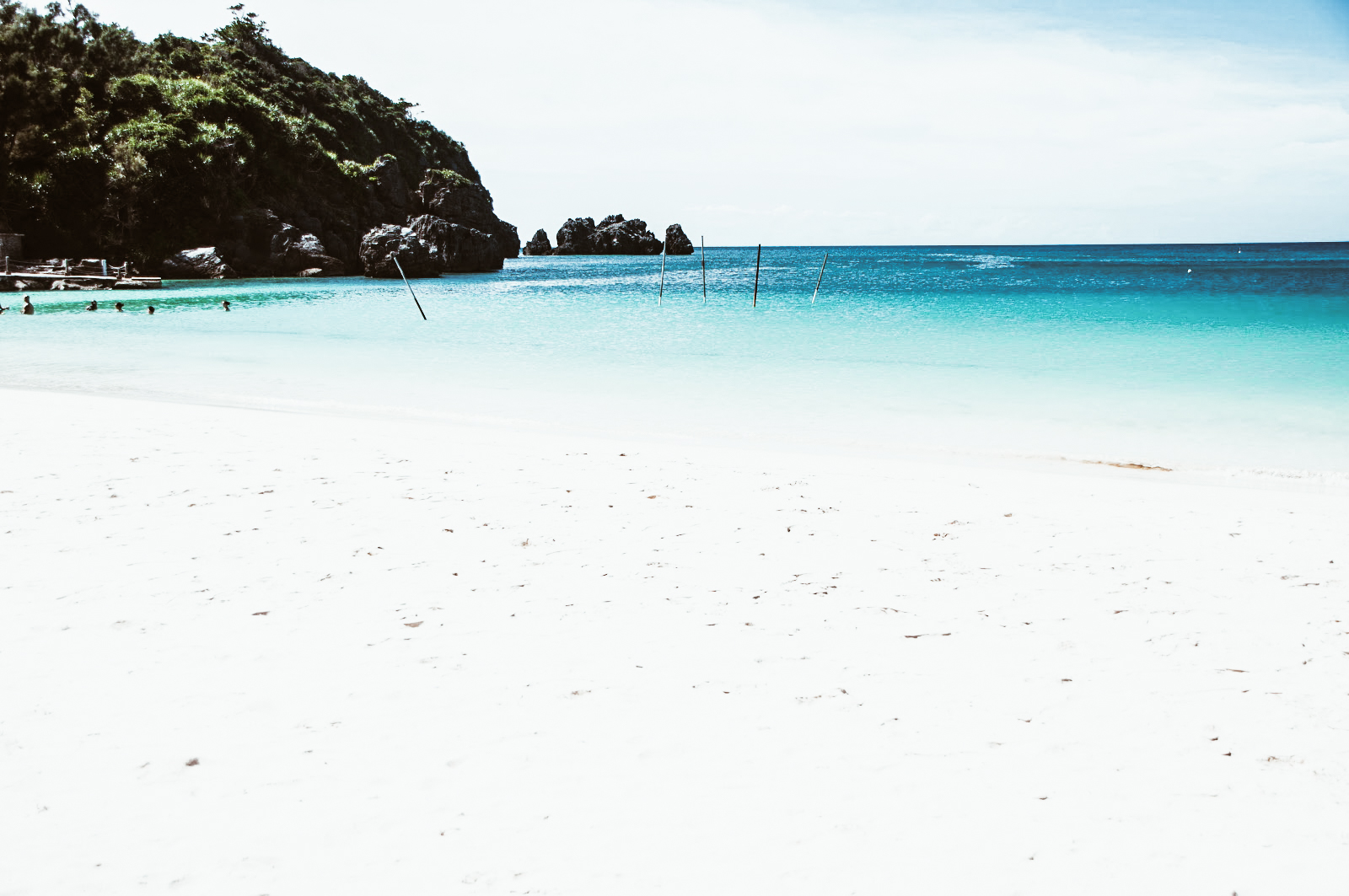
photo credits: marshallsabroad.com
If you really can't leave yet, we want to recommend a movie to enjoy the beauties of Okinawa: Karanukan (カ ー ラ ヌ カ ン). Romantic but with the aim of showing the beauty of this country, the film tells the story of photographer Hikaru Ooyama (GACKT) who decides to visit Okinawa. There, he meets Mami Ishigaki (Suzuka Kimura) and is fascinated by it, so much so that he chooses her as a model. During a photoshoot in the Yaeyama Islands, Hikaru is hit by a beam of light that momentarily causes him to lose consciousness and trace his muse. His life, from that moment on, is dedicated to finding Mami among Okinawa's incredible dream places. If you want to anticipate these magnificent places, Karanukan is the right movie for you.
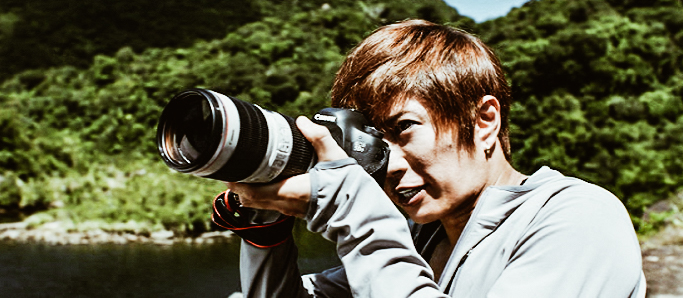
photo credits: gacktitalia.com
Usually, I only write articles of some interest to me, by now you know that I deal with Japanese history, Samurai and Japanese companies in Italy. I travel rarely, but this time passion has spoken for me.
As soon as you have the chance, leave for this wonderful island. You will discover that all the places you have always heard about, all the beaches, all the places you have always dreamed of, all come together here, in Okinawa.
Japan History: Sakamoto Ryōma
Sakamoto Ryōma (January 3, 1836 - December 10, 1867) is still recognized as one of the most important figures of the Tokugawa Shogunate and one of the greatest heroes of the Edo period.
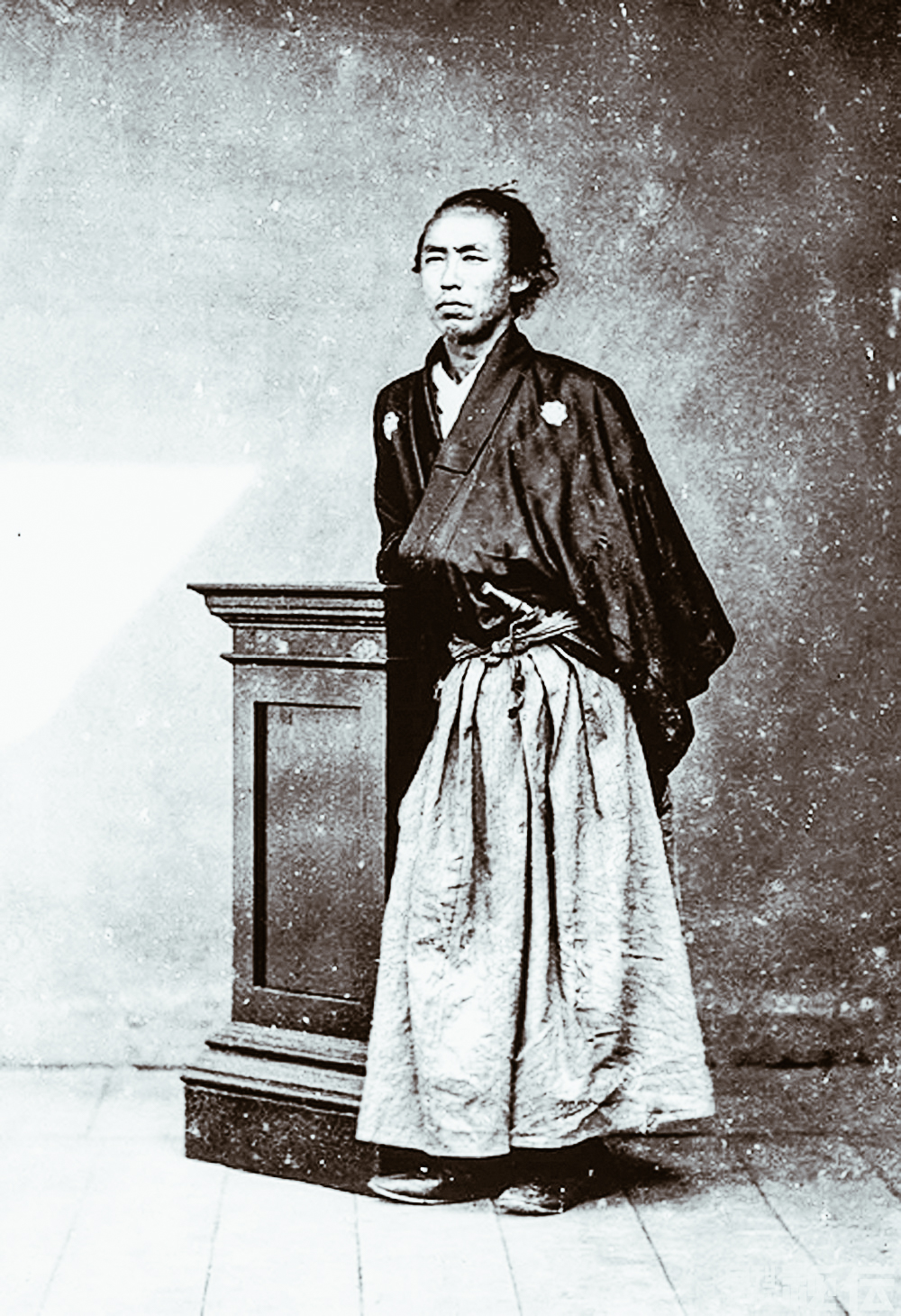
photo credits: budojapan.com
Early youth
He was born on the island of Shikoku, in the Tosa Han (toda's Kōchi Prefecture) on the fifteenth day of the eleventh month of Tenpō according to the Japanese calendar. His family was famous for being a great sake producer, thus obtaining the lowest rank of the Samurai category, the Gōshi (Samurai of the countryside). Tosa had a very clear separation between Joshi (high-ranking samurai) and Kashi (low-ranking samurai). Even in Sakamoto Ryōma's generation, the samurai degree of his family remained Kashi. At the age of twelve, Ryōma was enrolled in a private school, but it didn't last long, because his inclination to studies wasn't very strong.
Thanks to his older sister, he then enrolled in the Oguri-Ryu fencing classes when he was 14, after being bullied at school. In adulthood, he was a master swordsman. In 1853 he was allowed by his clan to go to Edo to improve his skills as a swordsman. There he enrolled as a student at Hokushin Ittō-ryū Hyōhō Chiba-Dōjō, where he received his diploma. He then became Shihan at Chiba-Dōjō and taught Kenjutsu to students along with Chiba Jūtarō Kazutane, his close friend. In 1858 he returned to Kōchi. However, four years later the Commodore Perry of the United States arrived with a fleet to force Japan out of its centuries-old policy of national isolation. In the same year, movements against foreigners, anti-Tokugawa movements and in support of the Emperor began to form.
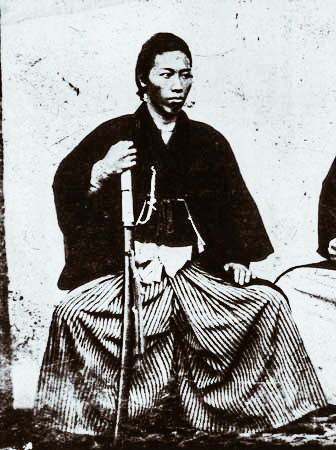
photo credits: jref.com
Sakamoto Ryōma and Takechi Hanpeita
His friend, Takechi Hanpeita (or Takechi Zuizan), organized Tosa's Loyalist Party "Kinnoto". Their political slogan was "Revere the emperor, expel the barbarians". The group consisted of about 2000 samurai, mostly of lower rank, who insisted on the reform of Tosa's government. As the group was not recognized, they began a plot to assassinate Yoshida Toyo, head of the Tosa domain. Ryōma participated in the plot without really supporting it.
Takechi asked for a revolution only for the Tosa clan, and Ryōma thought they would have to do something for all of Japan instead. He decided to leave Tosa and part with Takechi. In those days, no one was allowed to leave their clan without permission, on pain of death. One of Ryōma's sisters committed suicide precisely because of her brother's behavior.
In 1864, when the Tokugawa shogunate began to take a hard line, Ryōma fled to Kagoshima in the Satsuma Domain, under development as the main center for the anti-Tokugawa movement. Ryōma negotiated the secret alliance between the provinces of Chōshū and Satsuma. Satsuma and Chōshū were historically irreconcilable enemies, and Ryōma's position was seen as "neutral outsider".
Sakamoto Ryōma and the West
Ryōma was an admirer of democratic principles and studied the United States Congress and the British Parliament a lot. He loved these concepts so much that he took them as a model for the government of Japan after the Restoration.
Ryōma wrote the "Eight Proposals During the Expedition" while discussing the future model of the Japanese government with Gotō Shōjirō aboard a Tosa ship outside Nagasaki in 1867. Ryōma stressed the need for a democratically elected bicameral legislature and the drafting of a Constitution. Furthermore, he had considered the formation of a national army and fleet together with the regulation of gold and silver exchange rates. It is believed that Ryōma's proposals form the basis for the subsequent parliamentary system implemented after his death.
Sakamoto Ryōma and the Bakumatsu period
Ryōma pushed for national reform and left the domain, targeting Katsu Kaishu, a senior Tokugawa official.
When he finally managed to find his target, the latter calmly asked to be heard before he was killed. Katsu Kaishu then explained his plans to increase Japan's military strength through modernization and westernization. Instead of killing him as the plans were, Ryoma became his assistant. Together they created a naval force to be reckoned with.
Ryōma is often considered the "father of the Japanese Imperial Navy" because under the direction of Katsu Kaishū he worked to create a modern naval force. All this to allow Satsuma and Chōshū to stand comparison with the naval forces of the Tokugawa shogunate. Ryōma founded the private navy and the Kameyama Shachū trading company in the city of Nagasaki with the help of Satsuma.

photo credits: visitkochijapan.com
Chōshū's subsequent victory over the Tokugawa army in 1866 and the imminent collapse of the Tokugawa shogunate made Ryōma a precious figure for his former masters in Tosa. In fact, it is precisely in this period that he was recalled to Kōchi with many honors. Tosa's domain was anxious to get a negotiated agreement between the Shogun and the Emperor. This would have prevented Satchō's powerful Alliance from forcibly toppling Tokugawa and thus emerging as a new dominant force in the government of Japan. Ryōma again played a crucial role in the negotiations that led to the voluntary resignation of the Tokugawa Yoshinobu Shogun in 1867. With the arrival of the Meiji Restoration, thanks to Sakamoto Ryoma the Shogunate fell. Thus it was that Japan managed to come out of the 260-year Tokugawa Rule.
Ryōma often used the alias Saitani Umetarō (谷梅太郎) as he was often hunted by Bakufu supporters, like Shinsengumi members.
Sakamoto Ryōma's murder
On the night of December 10, 1867, Sakamoto Ryōma and his friend Nakaoka Shintaro stayed at the Omiya Inn in Kyoto. A group of assassins had gathered outside the inn. When one of them knocked on the door killing Ryōma's bodyguard, the rest of the group reached his room assassinating both him and Nakaoka.
The killers were never identified. However, members of the Shinsengumi and their leader Kondo Isami were accused and executed for the murder. Although the Mimawarigumi, members of the pro-Tokugawa group, confessed to the murder in 1870, no action was ever taken against them.
Sakamoto Ryōma's ultimate goal was not personal, but for the sake of Japan. His actions and beliefs have made him a national hero to this day.
Ryōma was a visionary who dreamed of an independent Japan without feudal traps. He was inspired by the example of the United States where "all men are created equal". He realized that to compete with an industrially and technologically advanced outside world, the Japanese had to modernize. It has also been seen as an intriguing mix of tradition and modernity. In fact, a symbol of these traits was his preference for the samurai dress with western footwear.
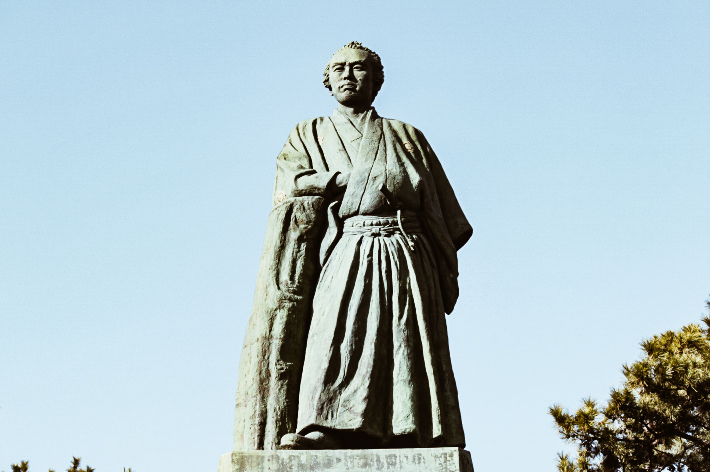
photo credits: tokyo2020.jp
Modern times
On 15 November 2003, the Kōchi airport was renamed Kōchi Ryōma Airport in his honor.
There is a Sakamoto Ryōma Memorial Museum (坂本龍馬記念館) south of Kōchi, with a large bronze statue of Ryoma overlooking the sea. The city of Kōchi has a number of Ryōma-themed attractions and places, including the Sakamoto Ryōma Birthplace Memorial. Furthermore, the Sakomoto Ryōma Hometown Museum shows the Kōchi center during Ryōma's childhood, including the relevant aspects that may have influenced his opinions. On November 15, 2009, the Hokkaido Sakamoto Ryōma memorial museum was built in Hakodate, Hokkaido.
Festa del Giappone @ Circolo Magnolia

On June 9, 2019, at the Circolo Magnolia located at Parco Idroscalo, an entire day dedicated to Japanese culture will be held. There will be many workshops, demonstrations and important personalities known in the world of the Rising Sun. Obviously, you can also taste the coveted Japanese food and sake.
Many are the workshop available for the audience! You can find the manga drawing workshop curated by Giappone in Italia, focusing mainly on the character design. Furthermore, you will find the Lykke Anholm workshop, the Italian ambassador of the KonMari method, focusing on the whole philosophy underlying the worldwide phenomenon of Marie Kondo. Also, have you ever heard of Kintsugi? It’s the ancient and very significant Japanese art of repairing ceramics with urushi lacquer and gold dust. The restorative artist Chiara Lorenzetti will explain this in the smallest detail.
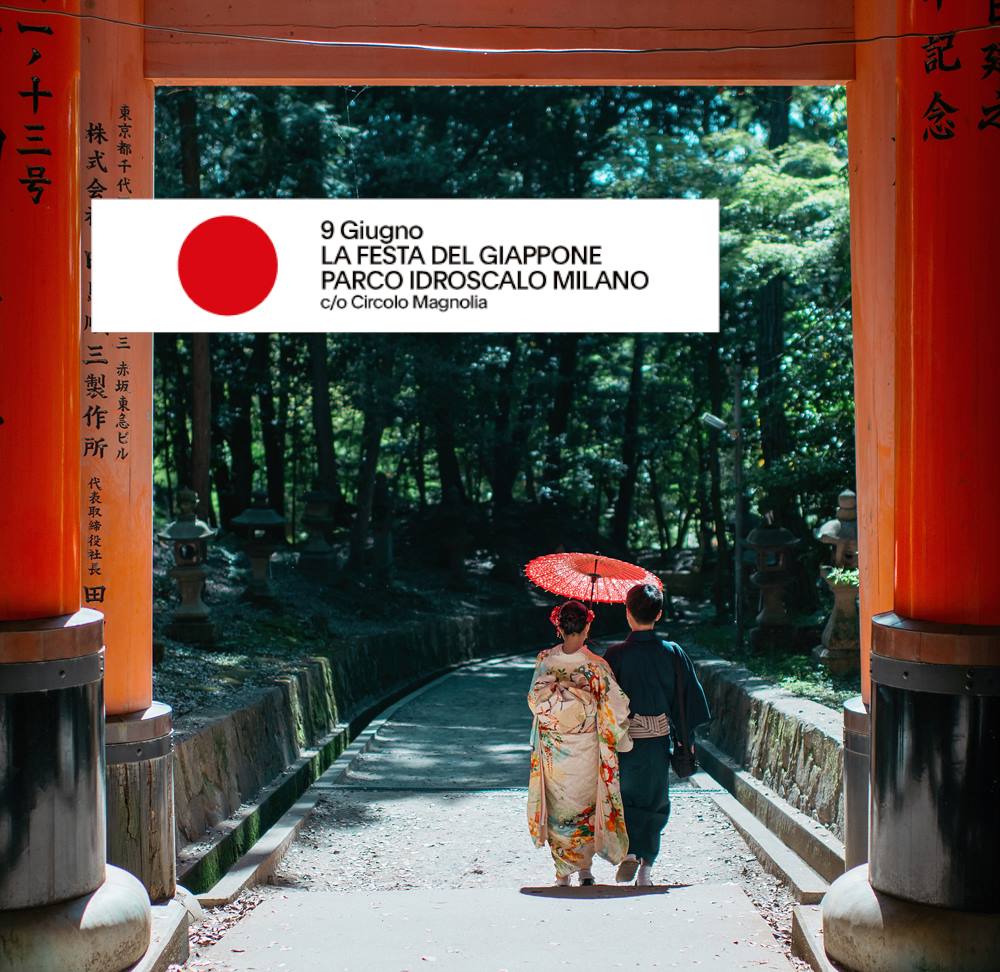
A dive into Japanese tradition with some demonstrations, including the Yukata Dressing by Mamiko Ikeda and the evocative Tea Ceremony by Alberto Moro. IFIORINELLARETE takes care of the demonstration of Kokedama, a technique in which a seedling is removed from its own pot and wrapped in a ball made with a mixture of different substrates, covered with fresh moss. The plant created can be placed on a flat surface, or left floating in the air for an even more suggestive effect. The famous Keiko Irimajiri will present her Bentō Showcooking while Luca Vecchi will tell us about the concept of his work Okaa-Sama | Honorable Mother.
And for all the people that love the Japanese language, Eurasia Language Academy will hold An interactive language course! Curious?
We’ll be waiting for you on June 9th at Circolo Magnolia, Parco idroscalo. We’ll be there, what about you??

Info & Prevendite
Pre-sale: bit.ly/Prevendite_LaFestaDelGiappone
Organisation: Associazione Culturale Giappone in Italia
Website: www.giapponeinitalia.org
Mail: info@giapponeinitalia.org
Japan History: Torii Suneemon

photo credits: japanworld.info
Torii Suneemon (1540 - 1575) was a Japanese samurai of the Torii family, known for his courage and for the incredible value demonstrated in the battle of Nagashino (1575). Of his youth, it is known that he was an ashigaru soldier who served Okudaira Sadamasa, a vassal of Tokugawa Ieyasu and master of the castle of Nagashino.
On June 17, 1575, after failing to capture Yoshida Castle in Toyohashi, 15,000 of Takeda Katsuyori's samurai attacked Nagashino Castle in modern Shinshiro City, Aichi Prefecture. Nagashino with only 500 men, was built on top of a cliff, where the Ure and the Kansa rivers divided and served as a natural moat. It was a strategically important castle, guarding the Tokugawa against the threat of northern Takeda. Takeda Katsuyori, son of the famous Takeda Shingen, was busy reaching the capital, Kyoto, in an attempt to gain control of the nation.
To get to Kyoto, they first had to conquer Mikawa and Owari, lands held by allies Tokugawa Ieyasu and Oda Nobunaga. Nagashino Castle was important as it threatened the supply lines of the Takeda clan.

photo credits: asianartscollection.com
The Takeda forces had surrounded the castle, and the brave Torii volunteered to leave the castle, swim along the river and cut off the nets drawn near the enemy. Later he would have to walk 25 km from Okazaki and call Tokugawa Ieyasu. After warning him and requesting reinforcements, Torii quickly returned to Nagashino where he was captured as he tried to return to the castle.
The story tells of how Torii Suneemon had been tied and crucified with straw ropes in plain sight to his compatriots from Nagashino castle. "Tell them reinforcements will not come, tell them to give up the castle and get out!" one of his captors hissed. Torii looked up at the castle shouting: "Men from the castle of Nagashino... Don't give up! Ieyasu's men are coming! Wait a little longer!" Following his exploit, he was silenced by a spear stuck in the stomach.
The forces of the Tokugawa clan and the Oda allies eventually arrived on the scene a week later with 38,000 soldiers, creating an important turning point in the history of Japan and the samurai war, the battle of Nagashino and Shitaragahara.
It is interesting to know that a Takeda Samurai, Ochiai Michihisa, was so impressed with Torii's loyalty and courage that in a battle he displayed a flag with the image of the crucified Samurai. That flag is now kept in the Tokyo University library.
The martyr Torii was promoted posthumously to the samurai class and his family continued to serve the Okudaira clan until the end of the Edo period. He entered the history books as one of the most courageous and faithful Samurai.
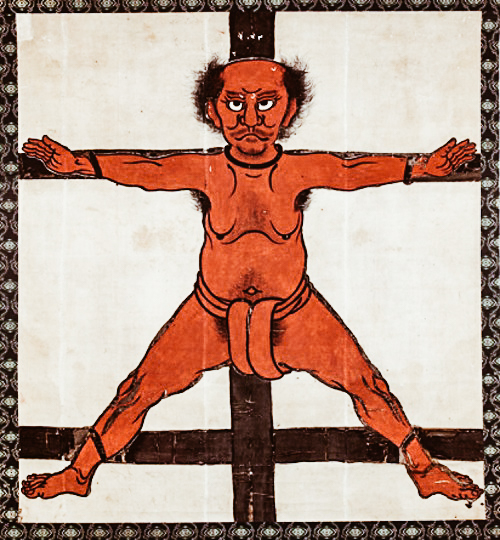
photo credits: japanworld.info
A curiosity: on the Lida line a railway station was opened bearing the name of the brave Samurai, a place not far from where he was crucified.
Japan History: Sanada Yukimura
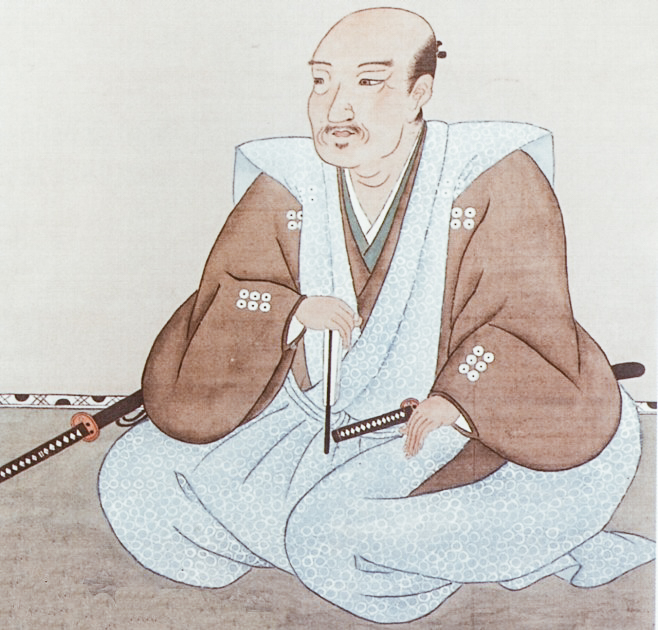
photo credits: wikipedia.org
Sanada (Yukimura) Nobushige was one of the greatest samurai of the Sengoku period. Second child of Sanada Masayuki and younger brother of Sanada Nobuyuki, he was never called "Yukimura" during his lifetime, since his real name was Nobushige. It seems that Yukimura was obtained at the end of the Edo period. Known as "Crimson Demon of War" for his blood-red banners and red armor, he was also recognized as "the greatest warrior of Japan" and even "The last Sengoku hero" by his peers.
As a young man, he was sent by his father as a hostage to the Uesugi clan in exchange for Uesugi's support against the Tokugawa. The father who later sided with Toyotomi Hideyoshi, as Uesugi had done, allowed him to return home to Ueda.
Sanada Nobushige served Hideyoshi directly. His first wife, Aki-hime, was the daughter of Otani Yoshitsugu even though adopted by Toyotomi Hideyoshi. Nobushige had seven daughters and three children with four wives, the last was born two months after his father's death.
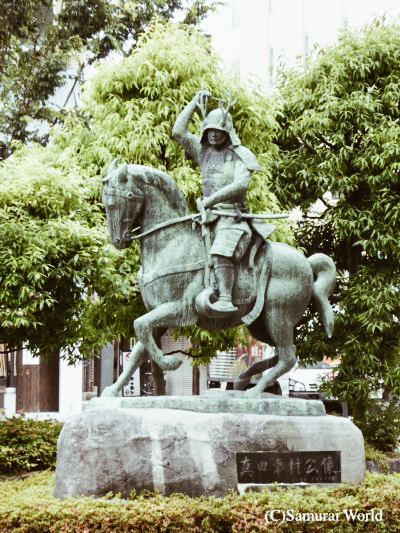
photo credits: samurai-world.com
Ueda Castle, built in 1583, was the home of the Sanada clan. The fact that it was well built was first tested in 1583 when the castle resisted the attack of a numerically superior Tokugawa force. The defeat would have been embarrassing for the Tokugawa in the future. Another similar siege of Ueda Castle in the 1600s at the time of the Battle of Sekigahara also saw Tokugawa Hidetada, son and heir of Ieyasu, who led his army along Nakasendo, strategically important. Along the way, he stopped and besieged Ueda Castle. Although there was a great distance from the battlefield of Sekigahara, events at Ueda Castle would have almost destroyed the intentions of the Tokugawa legions. The Sanada resisted long enough for Hidetada to arrive late to the battle itself, depriving Tokugawa of about 38,000 men. Nobushige commanded only 2,000 men inside the castle.
Sanada Masayuki and his son Nobushige kept Ueda's castle as an ally of Western forces, however, Sanada Nobuyuki, was fighting for the Tokugawa. This ensured that at least one member of the Sanada family would be among the winners, regardless of the outcome. This was clearly a plan to preserve the family name. Following Sekigahara, Nobushige and his father were deprived of their domain and exiled to the holy mountain, Koya.
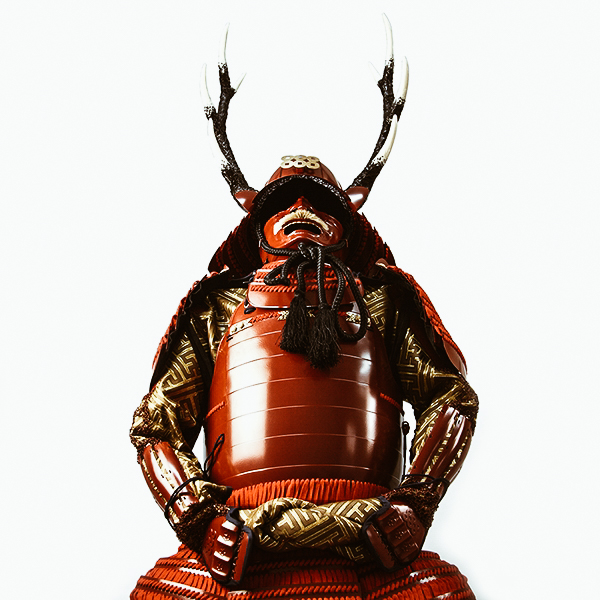
Photo Credits: tozandoshop.com
14 years after Sanada's father and son were sent into exile, Nobushige would rebel against the Tokugawa again during the winter siege of Osaka, and again the following year in the summer campaign. Nobushige had built a crescent-shaped fortress in the southwestern corner of Osaka Castle, known as Sanada Maru. The fortified outpost was surrounded by a wide, deep and dry moat. The earth of the moat was piled up inside, and along the top of this embankment, there was a simple two-story wooden wall, with platforms at regular intervals. Apparently, the Sanada Maru was armed with cannons along the walls. Sanada Nobushige and about 7,000 men repeatedly repulsed around 25,000 Tokugawa allies. Sometimes the Sanada samurai left the borders of the Sanada Maru to counter the enemy troops.
The following year, during the summer siege of Osaka, Sanada Nobushige commanded the right flank of Toyotomi's forces. On June 3, despite being completely exhausted from the battle against Date Masamune's forces, Nobushige and his men had returned to Osaka Castle to find the 150,000 Tokugawa men preparing to make one final assault. Hoping to catch them off guard and destroy their formations, Nobushige sent his son, Daisuke, to instruct Hideyori to look for opportunities to get out of the castle and attack the Tokugawa.
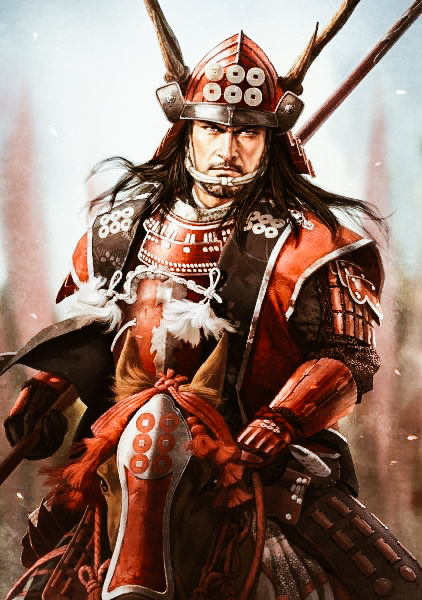
photo credits: pinterest.it
However, at the time of the attack, Hideyori appears to have lost control and failed to launch a counterattack that could have reversed the siege. The Sanada troops were overwhelmed. Seriously wounded in the fierce battle against Matsudaira Tadanao who had pledged him for most of this day, from 12 to 17, Nobushige sat under a pine tree in the Yasui Shrine grounds, unable to continue. When the wave of enemy forces approached, he calmly said his name, and saying that he was too tired to continue fighting, he allowed a Tokugawa samurai named Nishio Nizaemon to take his head. Sanada Nobushige was 47 years old. The news of his death spread rapidly and the morale of Osaka's troops fell.
The name Yukimura was known throughout Japan due to its fearless fighting.
Shimazu Iehisa of Satsuma praised Yukimura, writing "Sanada was the greatest warrior in Japan, stronger than any warrior in the stories of ancient times. The Tokugawa army was half defeated. I say this only in general."
A statue of the weary warrior is now found under the second-generation pine tree in the ground of the sanctuary.
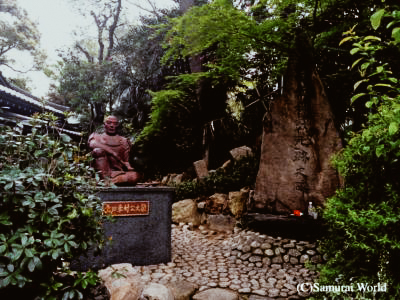
photo credits: samurai-world.com
Japan Tradition: Saigō Takamori

photo credits: jpninfo.com
Saigō Takamori (1828-1877) is remembered both for his important role in the Meiji Restoration which overthrew the shogunate in 1868 and for his failed rebellion against the new government less than a decade later. Although he died a renegade, a government pardon rehabilitated his reputation and 150 years after the Meiji restoration, the spotlight is again on the last samurai.
Saigō's rise to power began in 1854 when he was recruited by Shimazu Nariakira, the daimyo of the Satsuma domain (now Kagoshima prefecture), to accompany him to the capital of Edo (now Tokyo). As a low-ranking official, Saigō was involved in bridge construction projects and roads. He managed to capture Nariakira's attention with a series of memoranda on the agricultural administration that he submitted to the provincial government. Officially he was employed in Edo as a gardener, but his duties went beyond plants. While in the capital, Saigō made contact with the main personalities who opposed the shogunate. The outdoor work offered a comfortable cover for Nariakira and Saigō to meet and talk, avoiding the obstacles they would face due to their large difference in rank.

photo credits: yabai.com
Saigō quickly built a network of loyalists from Mito (now Ibaraki Prefecture) and other domains. He won the trust of Nariakira with his simple and emotional nature, and over time the daimyo came to look for the opinions of the younger people. However, the situation began to change from 1857 when Abe Masahiro died. He elderly shogunate adviser who had helped ensure the succession of his close friend Nariakira as Satsuma daimyo. Nariakira himself died the following year and the power in Satsuma passed to his younger brother Shimazu Hisamitsu. Meanwhile, the conservative politician Naosuke had taken effective control of the shogunate, launching an important crackdown on the reformists.
Suffering from the loss of Nariakira and facing difficult political prospects, Saigō was determined to follow his teacher to the grave but was persuaded by Gessho, the chief priest of a Kyoto temple, to flee with Satsuma. However, once there, they threw themselves into the sea in Kagoshima Bay and Gessho drowned, but Saigō miraculously survived.
Over the next five years, Saigō suffered periods of exile on the islands of Amami Ōshima and Okinoerabujima. On Amami he was given some freedom and married a local woman. However, After a brief respite on his return from Amami, he was again exiled to an island after angering Hisamitsu. This period of imprisonment became an opportunity for serious reflection on his life and shaped his personality as a caring man of firm principles.
Iechika Yoshiki, Saigō’s biographer and researcher, argues that, unlike most people, he was not afraid of death. Having lost many people he loved and respected, including his parents, Nariakira and Gessho, he was not terrified of dying and saw it as a way to be reunited with his loved ones.

photo credits: nippon.com
Iechika says that Saigō believed that heaven had spared his life for a reason and that he would live to complete his divine call. This philosophy is linked to his famous motto “keiten aijin”, which means "Respect the sky and love people". According to Saigō, the questions of life and death were above human consideration and had to be left entirely to fate.
In 1864 Saigō reconciled with Hisamitsu and returned to the Kyoto political center as commander of the Satsuma army. After rejecting the anti-shogunate forces from the Chōshū domain (now Yamaguchi Prefecture) while attempting to enter the city, he was promoted to the rank of high officer. The event, known as the Hamaguri Gomon incident, was Saigō's first battle experience with an army. The same year, he became chief of staff of the shogunate army sent to punish Chōshū. In 1866, however, Satsuma and Chōshū entered an alliance mediated by Sakamoto Ryōma. Saigō took charge of the opposition forces that would eventually become soldiers of the new Meiji government.
In 1864 Saigō reconciled with Hisamitsu and returned to the Kyoto political center as commander of the Satsuma army. After rejecting the anti-shogunate forces from the Chōshū domain (now Yamaguchi Prefecture) while attempting to enter the city, he was promoted to the rank of high officer. The event, known as the Hamaguri Gomon incident, was Saigō's first battle experience with an army. The same year, he became chief of staff of the shogunate army sent to punish Chōshū. In 1866, however, Satsuma and Chōshū entered an alliance mediated by Sakamoto Ryōma. Saigō took charge of the opposition forces that would eventually become soldiers of the new Meiji government.
In January 1868, the imperial loyalists led by Satsuma and Chōshū proclaimed the restoration of power from the shogun to the emperor. The resistance of the shogunate supporters triggered the Boshin war later in that month. Although the conflict dragged on until the following year, a key victory for the Meiji troops came with the surrendering of Edo Castle in the spring of 1868. With the city and nation in danger and fighting in Edo, Saigō entered the stronghold of the shogunate with only a handful of followers, wanting to try negotiation. Surrounded by enemy soldiers, he faced the prospect of murder. The discussion and cooperation between Saigō and the leader of the shogunate Katsu Kaishū led to the peaceful delivery of the castle, as a "bloodless delivery".

photo credits: nippon.com
In Japan, Saigō Takamori, Ōkubo Toshimichi and Kido Takayoshi are considered the three great figures of the Meiji Restoration. However, according to Iechika, Saigō's success at Edo Castle was something the other two members of the trio could never have achieved. He claims that without Saigō, the Meiji Restoration would never have happened and that people today see the event favorably because of this. On the contrary, if the movement had caused a bloody civil war, it is likely that public sentiment would have been very different. Although Saigō was not the astute politician that Ōkubo was, he had a love and a spirit that the other could not match.
In 1871 Saigō joined the Meiji government and in 1873 he became an army general. However, he resigns a few later after losing a debate about his support for a military expedition to Korea. He returned to his home in the prefecture of Kagoshima, where he spent his time cultivating and hunting. However, In 1877, he was convinced to lead an army of dissatisfied Samurai in the Satsuma rebellion. Driven by government forces in the battles on Kyūshū, the army reached the last position at Shiroyama in Kagoshima. Saigō committed suicide after his soldiers were defeated. He was 49 years old.
Saigō is the likely inspiration for Katsumoto Moritsugu - played by Watanabe Ken in the 2003 film The Last Samurai. The film complains of the passage of bushidō (the way of the Samurai) through Katsumoto, as noted by the Civil War veteran Tom Cruise, Nathan Algren (the character has no direct historical equivalent).
Saigo's association with traditional values in a modernized Japan is why he was called "the last Samurai". Just 12 years after his failed rebellion, he was pardoned by the Meiji government and in 1898 a statue of Saigō and his dog was erected in Tokyo's Ueno Park. Almost a century and a half after his death, it remains a popular historical and cultural icon.

photo credits: madmonarchist.blogspot.com
Japan History: Tokugawa Ieyasu
 Photo credits: wikipedia.org
Photo credits: wikipedia.org
Tokugawa Ieyasu (徳川家康, Jan. 30, 1543 - June 1, 1616) was the founder and first shōgun of the Tokugawa shogunate, who effectively commanded the Battle of Sekigahara in Japan in the 1600s until the reconstruction of Meiji in 1868. Ieyasu obtained power in 1600, became shōgun in 1603, and abdicated in 1605 remaining in power until his death in 1616. He was one of the three unifiers of Japan, along with Lord Nobunaga and Toyotomi Hideyoshi.
Tokugawa Ieyasu, originally Matsudaira Takechiyo, was the son of Maytsudaira Hirotada, the daimyo of Mikawa of the Matsudaira clan and of Odai-no-kata, the daughter of the samurai lord Mizuno Tadamasa. His parents were 17 and 15 years old when Ieyasu was born.
In the year of his birth, the Matsudaira clan broke up. In 1543, Hirotada's uncle, Matsudaira Nobutaka, defeated the can Oda. This gave Oda Nobuhide a way to attack Okazaki. Hirotada divorced from Odai-no-kata by sending her back to his family to remarry again, in fact Ieyasu had 11 brothers and sisters.
As Oda Nobunaga continued to attack Okazaki, Hirotada in 1548 asked for help from Imagawa Yoshimoto who accepted the alliance.
Oda Nobuhide, having learned of this agreement, had Ieyasu kidnapped by his entourage on his way to Sunpu. Ieyasu was only five years old at the time.
Nobuhide threatened to execute Ieyasu unless his father broke all ties with the Imagawa clan. However, Hirotada refused, stating that sacrificing his son would show his seriousness in his pact with Imagawa. Despite this refusal, Nobuhide chose not to kill Ieyasu, but instead held him hostage for the next three years in the Manshoji Temple of Nagoya.
In 1549, when Ieyasu was 6 years old, his father Hirotada was assassinated by his own vassals, who had been corrupted by the Oda clan. Around the same time, Oda Nobuhide died during an epidemic. The death of Nobuhide has dealt a blow to the Oda clan. An army under the command of Imagawa Sessai besieged the castle where Oda Nobuhiro, the eldest son of Nobuhide and the new head of the Oda clan lived. With the castle about to fall, Sessai offered an agreement to Oda Nobunaga, the second son of Nobuhide. He offered to renounce the siege if Ieyasu had been delivered to Imagawa.

Photo credits: Rekishinotabi on flickr
The ascent to power (1556-1584)
In 1556 Ieyasu officially became an adult, with Imagawa Yoshimoto presiding over his genpuku ceremony. Following the tradition, he changed his name from Matsudaira Takechiyo to Matsudaira Jirōsaburō Motonobu. He was also allowed for a brief period to visit Okazaki to pay homage to his father's grave and to receive the homage of his nominal servants, guided by the karō Torii Tadayoshi.
A year later, he married his first wife, Lady Tsukiyama, a relative of Imagawa Yoshimoto, and changed his name to Matsudaira Kurandonosuke Motoyasu again. When he was allowed to return to Mikawa, Imagawa then ordered him to fight the Oda clan in a series of battles.
Motoyasu fought his first battle in 1558 at the Siege of Terabe. Terabe's castellan in western Mikawa, Suzuki Shigeteru, betrayed Imagawa by defeating Oda Nobunaga. This was within the territory of Matsudaira, so Imagawa Yoshimoto entrusted the campaign to Ieyasu and his servants of Okazaki. Ieyasu led the attack in person, but after taking external defenses, he began to be afraid of a counterattack, so he retired. As anticipated, the Oda forces attacked its lines, but Motoyasu was prepared and drove out the Oda army.
He managed to deliver supplies to the siege of Odaka in 1559. Odaka was the only one of the five frontier forts challenged by the Oda clan attack, nevertheless it remained in the hands of Imagawa. Motoyasu launched diversions against the two strong neighbors, and when the garrisons of the other forts came to his aid, Ieyasu's supply column managed to reach Odaka.
In 1560 the leadership of the Oda clan had passed to the brilliant leader Oda Nobunaga. Imagawa Yoshimoto, head of a large army (perhaps 25,000 people) invaded the territory of the Oda clan and Motoyasu was assigned a separate mission to capture the stronghold of Marune. So he and his men were not present at the Battle of Okehazama where Yoshimoto was killed in Nobunaga's surprise assault.
The Alliance with Oda
With the death of Yoshimoto and the Imagawa clan in a state of confusion, Motoyasu took the opportunity to assert his independence and bring his men back to the abandoned Okazaki castle to claim his place.
Motoyasu then decided to ally with the Oda clan. A secret agreement was needed because Motoyasu's wife, Lady Tsukiyama, and her newborn son, Nobuyasu, were held hostage to Sumpu by Imagawa Ujizane, Yoshimoto's heir.
In 1561, Motoyasu conquered the fortress of Kaminogō, detained by Udono Nagamochi, attacking in the night, setting fire to the castle and capturing two of the sons of Udono, who he used as hostages to free his wife and son.
In 1563 Nobuyasu was married to Nobunaga's daughter Tokuhime.
For the following years, Motoyasu undertook to reform the Matsudaira clan and make peace with Mikawa. He also strengthened his main vassals by assigning them lands and castles. These vassals included: Honda Tadakatsu, Ishikawa Kazumasa, Kōriki Kiyonaga, Hattori Hanzō, Sakai Tadatsugu and Sakakibara Yasumasa.
In the early days of Mikawa Ieyasu's daimyō he had difficult relationships with the temples of Jōdō, which became increasingly numerous in 1563-64.
During this period, the Matsudaira clan also faced a threat from a different source. Mikawa was an important center for the Ikkō-ikki movement, where the peasants united with the militant monks under the Jōdo Shinshū sect and rejected the traditional feudal social order. Motoyasu undertook several battles to suppress this movement in its territories, including the Battle of Azukizaka. In a fight, he was almost killed by two bullets that did not penetrate his armor. Both sides were using the new gunpowder weapons that the Portuguese introduced to Japan only 20 years earlier.
 Photo credits: wikipedia.org
Photo credits: wikipedia.org
Growing political influence
In 1567, he changed his name again, this time to Tokugawa Ieyasu. In doing so, he claimed the descent from the Minamoto clan. No evidence was actually found for this alleged lineage from the Emperor Seiwa. Yet, his family name was changed with the permission of the Imperial Court, after writing a petition, in which he was awarded the courtesy title Mikawa-no-kami.
Ieyasu remained an ally of Nobunaga and his soldiers were part of the Nobunaga army that conquered Kyoto in 1568. At the same time Ieyasu was expanding its territory. Ieyasu and Takeda Shingen, the head of the Takeda clan in the province of Kai, made an alliance with the aim of conquering the whole territory of Imagawa. In 1570, Ieyasu's troops conquered the castle of Yoshida (modern Toyohashi), and entered the province of Tōtōmi. Meanwhile, the Shingen troops conquered the province of Suruga (including the capital of Imagawa, Sunpu). Imagawa Ujizane fled to the castle of Kakegawa, which Ieyasu laid siege to. Ieyasu then negotiated with Ujizane, promising that if he surrendered, he would help Ujizane regain Suruga. THe latter had nothing left to lose, and Ieyasu immediately ended his alliance with Takeda, forcing a new alliance with Takeda's enemy, Uesugi Kenshin of the Uesugi clan. Through these political manipulations, Ieyasu obtained support from the samurai of the Tōtōmi province.
In 1570, Ieyasu established Hamamatsu as the capital of his territory, placing his son Nobuyasu at the head of Okazaki.
The same year, he led 5,000 of his men to support Nobunaga at the Battle of Anegawa against the Azai and Asakura clans.
Conflict with Takeda
In October 1571, Takeda Shingen, now an ally of the Odawara Hōjō clan, attacked the Tokugawa lands at Tōtōmi. Ieyasu asked Nobunaga for help, receiving from him about 3,000 soldiers. At the beginning of 1572 the two armies met in the battle of Mikatagahara. The considerably larger Takeda army, under the expert leadership of Shingen, overwhelmed the Ieyasu’s troops and caused serious casualties. Despite his initial reticence, Ieyasu was persuaded by one of his generals to withdraw. The battle was a great defeat, but in the interest of maintaining the appearance of a dignified retreat, Ieyasu shamelessly ordered the men of his castle to light torches, play drums and leave the gates open, to adequately receive the returning warriors. To the surprise and relief of the Tokugawa army, this spectacle made General Takeda suspicious, so instead of besieging the castle, they camped out for the night. This error would have allowed a band of Tokugawa ninja to raid the field in the following hours, further disrupting Takeda's disoriented army, and in the end, Shingen's decision resulted in the cancellation of the entire offensive. Incidentally, Takeda Shingen would not have had another chance to advance on Hamamatsu, much less on Kyoto, since he would have died shortly after the siege of Noda Castle a year later, in 1573.
In 1575, Takeda attacked Nagashino Castle in the province of Mikawa. Ieyasu appealed to Nobunaga for help and the result was that Nobunaga personally headed a very large army (about 30,000 fighters). The Oda-Tokugawa force of 38,000 fighters won a great victory on June 28, 1575, at the Battle of Nagashino, however Takeda Katsuyori survived the battle and retreated back to the province of Kai.
For the next seven years, Ieyasu and Katsuyori fought a series of small battles, following which Ieyasu's troops managed to wrest control of the Suruga province from the Takeda clan.
In 1579, Ieyasu's wife and his heir Nobuyasu were accused by Nobunaga of conspiring with Takeda Katsuyori to assassinate Nobunaga, whose daughter Tokuhime (1559-1636) was married to Nobuyasu. This is why Ieyasu ordered his wife to be executed and forced his eldest son, Nobuyasu, to commit seppuku. Ieyasu then named his third son, Tokugawa Hidetada, as heir, since his second son was adopted by another rising power: the general of the Oda clan, Toyotomi Hideyoshi, who would soon become the most powerful daimyo of Japan.
The end of the war with Takeda came in 1582 when a combined Oda-Tokugawa force attacked and conquered the province of Kai. Takeda Katsuyori was defeated at the Battle of Tenmokuzan and then committed seppuku.
 Uma containing the ashes of Tokugawa Ieyasu in Nikkō
Uma containing the ashes of Tokugawa Ieyasu in Nikkō
Photo credits: wikipedia.org
Death of Nobunaga
At the end of June 1582, Ieyasu was near Osaka and far from his territory when he learned that Nobunaga had been murdered by Akechi Mitsuhide. Ieyasu managed the dangerous journey back to Mikawa and he was mobilizing his army when he learned that Hideyoshi had defeated Akechi Mitsuhide in the battle of Yamazaki.
Nobunaga's death meant that some provinces, governed by Nobunaga's vassals, could be conquered. The head of the province of Kai made the mistake of killing one of Ieyasu's helpers so he promptly invaded Kai and took control. Hōjō Ujimasa, head of the Hōjō clan, responded by sending his much larger army to Shinano and then to the province of Kai. No battle was fought between the Ieyasu’s troops and the great army of Hōjō. However, after some negotiations, Ieyasu and Hōjō accepted an agreement that left Ieyasu in control of the provinces of Kai and Shinano, while Hōjō took control of the province of Kazusa (as well as pieces from both the provinces of Kai and Shinano).
At the same time (1583) a war was waged to rule Japan between Toyotomi Hideyoshi and Shibata Katsuie. Ieyasu took no position in this conflict, relying on his reputation both for prudence and for wisdom. Hideyoshi defeated Katsuie at the Battle of Shizugatake and with this victory, he became the most powerful daimyo in Japan.
Ieyasu and Hideyoshi (1584-1598)
In 1584 Ieyasu decided to support Oda Nobukatsu, the eldest son and heir of Oda Nobunaga, against Hideyoshi. This was a dangerous act and could have led to the annihilation of the Tokugawa clan.
The Tokugawa troops took the traditional Oda stronghold of Owari while Hideyoshi replied by sending an army there. The Komaki campaign was the only time one of Japan's great unifiers fought each other. The campaign proved to be undecided, and after months of marches and unsuccessful feuds, Hideyoshi resolved the war through negotiation. First made peace with Oda Nobukatsu, and then offered a respite to Ieyasu. The agreement was stipulated at the end of the year and Ieyasu’s second son, Ogimaru (also known as Yuki Hideyasu) became Hideyoshi’s adoptive son.
Ieyasu's aide, Ishikawa Kazumasa, chose to join the daimyo and so he moved to Osaka to be with Hideyoshi. However, few other Tokugawa keepers have followed this example.
Hideyoshi was understandably suspicious of Ieyasu, and this was five years before they fought as allies. The Tokugawa did not participate in the invasions of Hideyoshi of Shikoku and Kyūshū.
In 1590, Hideyoshi attacked the last independent daimyo in Japan, Hōjō Ujimasa. The Hōjō clan ruled the eight provinces of the Kantō region in eastern Japan. Hideyoshi ordered them to submit to his authority, but they refused. Ieyasu, even if he was a friend and occasional ally of Ujimasa, joined his great strength of 30,000 samurai with the huge Hideyoshi army of about 160,000 men. Hideyoshi attacked several castles on the edge of the Hōjō clan with most of his army besieging Odawara Castle. Hideyoshi's army captured Odawara after six months. During this siege, Hideyoshi offered a radical deal to Ieyasu. He offered to Ieyasu the eight provinces of Kantō that were about to take from Hōjō in exchange for the five provinces Ieyasu controlled at the time, including Ieyasu’s one, Mikawa. Ieyasu accepted this proposal. Prey to the overwhelming power of the Toyotomi army, the Hōjō accepted the defeat, the top leaders Hōjō killed themselves and Ieyasu entered the field taking control of their provinces, putting an end to the clan kingdom of over 100 years.
The Battle of Sekigahara (1598-1603)
Hideyoshi, after another three months of illness, died on September 18, 1598. He was nominally succeeded by his young son Hideyori but, at only five years, the real power was in the hands of the regents. In the next two years Ieyasu made alliances with various daimyōs, especially those who had no love for Hideyoshi. Fortunately for Ieyasu, the oldest and most respected, Toshiie Maeda, died just a year later. With Toshiie's death in 1599, Ieyasu led an army to Fushimi and conquered Osaka Castle, Hideyori's residence. This angered the three remaining regents and began to structure their plans on all fronts for the war. It was also the last battle of one of Ieyasu's most loyal and powerful servants, Honda Tadakatsu.
The opposition to Ieyasu focused on Ishida Mitsunari, a powerful daimyo who was not one of the regents. Mitsunari conceived Ieyasu's death, and news about this plot reached some of the Ieyasu generals. They tried to kill Mitsunari but he escaped and obtained protection from none other than Ieyasu himself. It is not clear why Ieyasu protected a powerful enemy from his men, but he was a strategist and may have thought it would be better to drive the enemy army with Mitsunari rather than one of the regents.
Almost all Japanese daimyōs and samurai split into two factions: the western army (Mitsunari group) and the eastern army (anti-Mitsunari group). Ieyasu supported the anti-Mitsunari group and formed them as its potential allies. Ieyasu’s allies were the Date clan, the Mogami clan, the Satake clan and the Maeda clan. Mitsunari allied himself with the other three regents: Ukita Hideie, Mōri Terumoto and Uesugi Kagekatsu and many daimyō from the eastern end of Honshū.
In June 1600, Ieyasu and his allies transferred their armies to defeat the Uesugi clan, who was accused of planning an uprising against the Toyotomi administration. Before arriving in the territory of Uesugi, Ieyasu learned that Mitsunari and his allies had moved their army against Ieyasu. He held a meeting with the daimyos and they agreed to follow him, so he led most of his army west to Kyoto. At the end of the summer, Ishida's forces captured Fushimi.
Ieyasu and his allies marched along the Tōkaidō, while his son Hidetada followed the Nakasendō with 38,000 soldiers. A battle against Sanada Masayuki in Shinano province delayed Hidetada's forces, so they did not arrive in time for the main battle.
Fought near Sekigahara, this battle was the largest and one of the most important battles in Japanese feudal history. It began on October 211600, with a total of 160,000 men facing each other. The battle of Sekigahara ended with a complete victory of Tokugawa. The western block was crushed and in the following days Ishida Mitsunari and many other Western nobles were captured and killed and Tokugawa Ieyasu was now the de facto governor of Japan.
Immediately after the victory at Sekigahara, Ieyasu redistributed the land to the vassals who had served him, he left some the daimyōs unharmed, like the Shimazu clan, but others were completely destroyed. Toyotomi Hideyori (Hideyoshi's son) lost most of his territory that was under the management of the western daimyō, and was degraded to ordinary daimyō, not to a governor of Japan. In subsequent years the vassals who had sworn loyalty to Ieyasu before the battle became known as fudai daimyō, while those who promised him loyalty after the battle (in other words, after his power was unquestioned) were known as Tozama daimyō. The latter were considered inferior to the Fudai daimyōs.
Shōgun (1603-1605)
On March 24, 1603, Tokugawa Ieyasu received the shōgun title from Emperor Go-Yōzei and he was 60 years old. He had survived all the other great men of his time: Nobunaga, Hideyoshi, Shingen, Kenshin. As shōgun, he used his last years to create and consolidate the Tokugawa shogunate, which inaugurated the Edo period and was the third shogunal government (after Kamakura), claiming the descent from the Minamoto clan, through the Nitta clan. His descendant will then marry into the Taira clan and the Fujiwara clan. The Tokugawa shogunate ruled Japan for the next 250 years.
Following a well-established Japanese model, Ieyasu abdicated his official shōgun position in 1605 and his successor was his son and heir, Tokugawa Hidetada. There may have been several factors that contributed to his decision, including his desire to avoid being bound by ceremonial duties, to make it harder for his enemies to attack the true center of power and to ensure a smoother succession of his son. The abdication of Ieyasu had no effect on the practical extension of his powers or his government. However, Hidetada assumed the formal role of the shogunal bureaucracy.
Ōgosho (1605-1616)
Ieyasu, as a retired shōgun (大 御所 ōgosho), remained the effective ruler of Japan until his death. He retired to Sunpu Castle, but also oversaw the construction of Edo Castle, an impressive construction project that lasted for the rest of Ieyasu's life. The result was the biggest castle in all of Japan, the cost of building it was supported by all the other daimyōs, while Ieyasu collected all the benefits. The central donjon, or tenshu, burned in 1657 and today, the Imperial Palace is in place of that castle.
In 1611 Ieyasu leading 50,000 men, visited Kyoto to witness the coronation of Emperor Go-Mizunoo. In Kyoto, Ieyasu ordered the reconstruction of the imperial court and buildings, forcing the remaining Western daimyos to sign an oath of loyalty to him.
In 1613, he composed the Kuge Shohatto (公家諸法度), a document that submitted the court under the daimyo’s close supervision, leaving them as simple ceremonial nominees.
In 1615 Ieyasu prepared the Buhat shohatto (武家諸法度), a document that illustrated the future of the Tokugawa regime.
Relations with foreign powers
Like Ōgosho, Ieyasu also oversaw diplomatic affairs with the Netherlands, Spain and England. Ieyasu chose to remove Japan from European influence from 1609, although the shogunate continued to grant preferential commercial rights to the Dutch East India Company and allowed them to maintain a "factory" for commercial purposes.
From 1605 until his death, Ieyasu frequently consulted with the English master of arms and pilot, William Adams, who, fluent in Japanese, assisted the shogunate in the negotiation of commercial relations.
Significant attempts to limit the influence of Christian missionaries in Japan date back to 1587 during Toyotomi Hideyoshi's shogunate. However, in 1614, Ieyasu was sufficiently concerned about the Spanish territorial ambitions that he signed an edict of Christian expulsion. The edict banished the practice of Christianity and led to the expulsion of all foreign missionaries. Although some minor commercial operations remained in Nagasaki, this edict drastically limited foreign trade and marked the end of Christian witness open in Japan until 1870.
Siege of Osaka
The last threat to Ieyasu's dominion was Toyotomi Hideyori, Hideyoshi’s son and rightful heir. He was now a young daimyo who lived in Osaka Castle. Many samurai who opposed Ieyasu gathered around Hideyori, claiming to be the legitimate ruler of Japan. Ieyasu criticized the opening ceremony of a temple built by Hideyori because it was as if he had prayed for the death of Ieyasu and the ruin of the Tokugawa clan. Ieyasu ordered Toyotomi to leave Osaka Castle, but the inhabitants refused and summoned the samurai to gather inside the castle. Then the Tokugawa, with a huge army led by Ieyasu and the shōgun Hidetada, besieged Osaka Castle in what is now known as the "winter siege of Osaka". In the end, Tokugawa was able to join the negotiations and an armistice after the attack and after threatening Hideyori's mother, Yodo-dono. However, once the treaty was agreed upon, Tokugawa filled the castle's outer moats with sand so that his troops could cross it. Through this stratagem, Tokugawa obtained a huge tract of land through negotiation and deception. Ieyasu returned to Sunpu Castle, but after Toyotomi refused another order to leave Osaka, he and his allied army of 155,000 soldiers attacked Osaka Castle again in the "Osaka Summer Siege".
Eventually, in 1615, Osaka Castle fell and almost all the defenders were killed including Hideyori, his mother (Hideyoshi's widow, Yodo-dono) and his newborn son. His wife, Senhime (Ieyasu’s niece), pleaded to save the lives of Hideyori and Yodo-dono, but Ieyasu refused and forced both to commit a ritual suicide, or perhaps both killed. In the end, Senhime was sent back to the Tokugawa clan alive.
The death
Ieyasu died at the age of 73 in 1616. It is thought that the cause of death was cancer or syphilis. The first Tokugawa shogun was posthumously deified with the name Tōshō Daigongen, the "Great Gongen, the light of the east". It is believed that a Gongen is a Buddha who appeared on Earth in the form of a kami to save sentient beings.
In life, Ieyasu had expressed th desire to be deified after his death to protect his descendants from evil. His remains were buried in the Gongen mausoleum in Kunōzan, Kunōzan Tōshō-gū. As a general opinion, many people believe that after the first anniversary of his death, his remains were buried again in the Nikkō Shrine, Nikkō Tōshō-gū and they are still there today. Neither of the two sanctuaries offered to open the tombs, so the location of the physical remains of Ieyasu is still a mystery. The architectural style of the mausoleum became known as gongen-zukuri, or gongen style. First he was given the Buddhist name Tosho Dai-Gongen, then after his death he was changed to Hogo Onkokuin.
 Ieyasu Tomb in Tōshō-gū
Ieyasu Tomb in Tōshō-gū
Photo credits: wikipedia.org
Ieyasu's rule era
Ieyasu had a number of qualities that enabled him to rise to power. He was both attentive and audacious, in the right times and in the right places. Calculating and subtle, Ieyasu changed alliances when he thought he would benefit from the change. He allied himself with the late Hōjō clan, then he joined the army of conquest of Hideyoshi, who destroyed Hōjō and he himself took over their lands. In this he was like the other daimyo of his time. That was an era of violence, sudden death and betrayal. He was neither very popular nor personally popular, but he was feared and respected for his leadership and his cunning. For example, he wisely kept his soldiers out of Hideyoshi's campaign in Korea.
He was capable of great loyalty: once he allied himself with Oda Nobunaga, he never went against him, and both leaders took advantage of their long alliance. He was known to be loyal to his friends, and was said to have a close friendship with his vassal Hattori Hanzō. It is said, however, that he remembered the wrongs he had suffered and that he executed a man because he had insulted him when he was young.
Ieyasu protected many former Takeda servants from the wrath of Oda Nobunaga, who was known to harbor a bitter rancor toward Takeda. But he also knew he was ruthless, for example, he ordered the executions of his first wife and his eldest son, a son-in-law of Oda Nobunaga and he was also Hidetada's wife uncle.
He was cruel, implacable and ruthless in eliminating Toyotomi survivors after Osaka. For days, dozens and dozens of men and women were hunted down and executed, including Hideyori’s eight-year-old son from a beheaded concubine.
Unlike Hideyoshi, he had no desire to win anything outside of Japan. He just wanted to bring order, end the open war and rule Japan.
While at the beginning it was tolerant of Christianity, its attitude changed after 1613 and Christian executions increased sharply.
Ieyasu's favorite pastime was falconry. He considered it an excellent training for a warrior. "When you go to the countryside, you learn to understand the military spirit and the hard life of the lower classes: you exercise your muscles and you train your limbs. You can walk and run and become indifferent to the heat and cold, and therefore it is very unlikely that you may suffer from some disease ". Ieyasu often swam and even in old age it is said that he swam in the moat of Edo Castle.
He also took a scholarship and religion, attending scholars such as Hayashi Razan.
Two of his famous quotes
Life is like a long journey with a heavy burden. Let your pace be slow and steady, do not stumble. Persuade yourself that imperfection and inconvenience are the greatest thing of mortals, and there will be no room for dissatisfaction or despair. When ambitious wishes arise in your heart, remember the days of extremism that you went through. Tolerance is the root of all tranquility and security forever. Watch the wrath of your enemy. If you only know what it means to conquer, and you do not know what it means to defeat. Find flaws in yourself rather than others.
The strong virile in life are those who understand the meaning of the word patience. Patience means limiting one's inclinations. There are seven emotions: joy, anger, anxiety, adoration, pain, fear and hate, and if a man does not give way to these he can be called a patient. I'm not as strong as I could be, but I always knew and practiced patience. And if my descendants want to be as they are, they have to study patience.
Japan History: Forty-seven Ronin
FORTY-SEVEN RŌNIN
A band of rònin (samurai without leader) avenged the death of their master. The event is known as the revenge of the forty-seven rōnin (四 十七 士 Shi-jū-shichi-shi, forty-seven samurai), also as the Akō incident (Akō jiken) or Akō's revenge, and is considered an historical event in Japan.

Photo Credits: Wikipedia.org
The story tells of a group of samurai remaining without leader after their daimyō Asano Naganori was forced to execute seppuku for assaulting Kira Yoshinaka, a court official whose title was Kōzuke no suke. After waiting and planning for a year, the rōnin avenged their master's honor by killing Kira. In turn, they were forced to commit seppuku because of the murder crime. This story has been made popular in Japanese culture as a symbol of loyalty, sacrifice, perseverance and honor, values people should look for in their daily lives. The story's popularity grew during the Meiji era, when Japan underwent rapid modernization, and the legend became important in national heritage and identity.
The fictional stories of the Forty-seven Rönin are known as Chūshingura. The story has been made popular in numerous shows, including bunraku and kabuki. Because of the shogunate laws of censorship in the Genroku era, which prohibited the portrayal of current events, the names were changed. The first Chūshingura was written about 50 years after the event.
The censorship laws had subsided a bit 75 years later, at the end of the eighteenth century, when Isaac Titsingh recorded for the first time the history of the forty-seven rōnin as one of the significant events of the Genroku era. It continues to be popular in Japan, and every year on December 14, in the Sengakuji Temple, where Asano Naganori and the rōnin are buried, a festival is held to commemorate the event.
In 1701, two daimyōs, Asano Takumi-no-Kami Naganori and Lord Kamei Korechika of the Tsuwano domain, were ordered to organize a reception for the emperor's messengers to the castle of Edo, during their sankin-kōtai service to the shōgun .
Asano and Kamei were to receive instructions on the necessary court code from Kira Kozuke-no-Suke Yoshinaka, a powerful Tokugawa Tsunayoshi shogunate official. He got very angry with them, either because of the insufficient gifts they offered him, or because they could not provide the bribe requests. Other sources describe him as naturally rude and arrogant or corrupt, this behavior offended Asano, a devoutly moral confucian. According to some reports, it seems that Asano was not familiar with the complexities of the shogunate court and had not shown the right amount of deference to Kira.
Initially, Asano endured everything stoically, while Kamei raged and prepared to kill Kira to avenge the insults. However, Kamei's advisors avoided the disaster for their lord and teamed up by collecting and giving Kira a big bribe; Kira then began to treat Kamei well and this contributed to calm him down.
However, Kira continued to treat Asano hard to the point of insulting him, calling him a country farmer without good manners, and Asano eventually stopped holding back. At Matsu no Ōrōka, the main hallway of Honmaru Goten residence, Asano lost his temper and attacked Kira with a dagger, wounding him in the face. They had to intrude the guards to separate them.
Kira's injury was not severe, however attacking a shogunate official within the boundaries of the shogun's residence was considered a serious crime. Any violence was completely forbidden in Edo's castle. Akō's daimyō had used his dagger inside Edo Castle, and for this crime, he was ordered to make seppuku. Asano's assets and lands had to confiscated after his death, his family had to be ruined, and his servants had to become rōnin,according to the general rule of the time.
The news arrived to Ōishi Kuranosuke Yoshio, Asano's chief adviser, who took over the command and transferred the Asano family before delivering the castle to government agents.
Forty-seven men, among the over 300, and especially their leader Ōishi, refused to allow their lord to take revenge. They teamed up in secret swearing to avenge their master and kill Kira, even though they knew they would be severely punished for that.
Kira was however well guarded and his residence had been protected. The ronin realized they should not rise Kira’s and other shogunate authorities suspicion, so they dispersed and became merchants and monks.
Ōishi took residence in Kyoto and began to frequent brothels and taverns. Kira feared a trap and sent spies to monitor the former servants of Asano.
One day, Ōishi, returning home drunk, fell down and fell asleep in the street. A man, Satsuma, was so enraged by this behavior of a samurai that he began to insult him, kicking him in the face and spitting on him.
Not long after, Ōishi divorced from his faithful wife after twenty years of marriage. He did not want to harm her her when the rōnin would have taken their revenge. He sent her away with their two younger children to live with her parents. He asked their eldest son, Chikara, whether he would have preferred to stay and fight or leave. Chikara stayed with his father.
Ōishi started to behave in a strange way and very different from the samurai style. He attended geishas (particularly Ichiriki Chaya), he drank every night and spoke obscenely in public. Ōishi's servants bought a geisha, hoping she would calm him down. All this was a plot to free Ōishi from Kira’s spies.
Kira's agents reported all this to Kira. Kira was then convinced he was safe from the servants of Asano, considering one year and a half elapsed he judged them without the courage to avenge their master. Thinking they were harmless, he lowered his guard.
The rest of the rōnin gathered in Edo, and in their roles as merchants and workers, had access to Kira's house, becoming familiar with the environment and people. Okano Kinemon Kanehide married the daughter of one of the builders of the house, managing to get the project. All this was reported to Ōishi. Others gathered and transported their weapons to Edo.
After two years, Ōishi was convinced that Kira was completely unaware, and everything was ready, He left Kyoto, avoiding the spies watching him, and joined the whole band gathered in a secret meeting place in Edo to renew their oaths.
On January 30, 1703 early in the morning, Ōishi and another rōnin attacked Kira Yoshinaka's home in Edo. According to a carefully defined plan, they would divide into two groups and would attack armed with swords and bows. A group, led by Ōishi, would attack the main gate; the other, led by his son, Ōishi Chikara, would attack the house through the back gate. A drum would sound the simultaneous attack, and a whistle would signal Kira's death.
Once dead, they planned to cut Kira's head and place it as an offering on their master's grave. They would then wait for their planned death sentence. All this had been agreed during a final dinner, during which Ōishi had asked to be careful and save women, children and other defenseless people.

Photo Credits: Wikipedia.org
Ōishi had four men at the fence and entered the caretaker's house, capturing and binding the guard. He then sent messengers to all neighboring houses, to explain that they were not robbers, but servants avenging the death of their master, and that no harm would be done to others: the neighbors were all safe. One of the rōnin climbed up to the roof and announced aloud to the neighbors that the matter was an act of revenge. The neighbors, who hated Kira, were relieved and did nothing to thwart the plan.
Dopo aver appostato gli arcieri per impedire agli abitanti di chiedere aiuto, Ōishi suonò il tamburo per iniziare l'attacco. Ten of the Kira keepers prevented the attack on the house from the front, but Chiishi Chikara's side is attacked from the back.
Following setting up of the archers to prevent house residents asking for help, Oishi played the drum to start the attack. Ten of the Kira keepers prevented the attack of the house from the front, allowing Chiishi Chikara to attack from the back.
Kira, terrified, took refuge in a closet on the veranda, along with his wife and his maids. The rest of his servants, sleeping in the barracks outside, tried to enter the house to save him. After passing the defenders at the front of the house, the two parts led by father and son joined and fought the servants who were entering. The latter, realizing they were about to lose, tried to ask for help, but their messengers were killed by the archers already set up to prevent this.
After a fierce fight, the last of Kira's servants was defeated; the ronin killed 16 men of Kira and wounded 22, including his nephew. However, no signs about Kira. They searched the house, they heard women and children cry. They were beginning to despair, when Ōishi checking Kira's bed, discovered that it was still warm, so he knew Kira could not be far away.
In a courtyard hidden in the back, they discovered a man who was hiding and was easily disarmed.
He refused to say who he was, the ronin however knew he was Kira and they whistled. The rōnin gathered and Ōishi, with a lantern, confirmed he was indeed Kira and as a final proof, he discovered on his head a scar of Asano's attack.
Ōishi knelt, and in consideration of Kira’s high degree, he respectfully addressed him, telling him that they were Asano's servants, come to avenge him as the true samurai should, and inviting him to die like a true samurai should , killing himself. Ōishi said he would act like a kaishakunin ("second", the one beheading a person who committed seppuku to spare him being unworthy of death) and offered him the same dagger that Asano used to kill himself.
However, no matter how much they begged him, Kira crouched, wordlessly trembling. Seeing that it was useless to continue, Ōishi ordered the other rōnin to killed him by cutting off his head with the dagger.
They turned off all the lamps and fires in the house and left with Kira's head.
One of the rōnin, Terasaka Kichiemon, was ordered to go to Akō and report that their revenge had been completed. (Although the role of Kichiemon as a messenger is the most accepted version of the story, other sources see him escape before or after the battle).
The rōnin, on their way back to Sengaku-ji, stopped in the street to rest and refresh themselves.

Photo Credits: Wikipedia.org
At dawn, they quickly brought Kira's head from his residence to the tomb of their lord in the temple of Sengaku-ji, marching for about ten kilometers across the city, causing a great sensation on the road. The story of revenge spread rapidly and everyone praised them and offered them refreshment during their journey.
Arrived at the temple, the remaining 46 rōnin (all except Terasaka Kichiemon) washed Kira's head in a well, and set it down with the dagger in front of Asano's tomb. They then offered prayers to the temple and gave the temple monk the remaining money, asking him to bury them decently and offer prayers for them. The group was divided into four parts and placed under the guard of four different daimyōs.
Two friends of Kira came to take his head for burial.
Edo shogunate’s officials were embarrassed. The samurai had followed the precepts by avenging their lord's death; however they also challenged the shogunate's authority by executing revenge, which was forbidden. As expected, the rōnin were sentenced to death for Kira's murder; the shogun eventually ordered them to commit honorably seppuku instead of having them executed as criminals. It is known that each of the assailants ended his life in a ritual manner. Ōishi Chikara, the youngest, was only 15 years old on the day of the attack, and only 16 the day he committed seppuku.
Each of the 46 rōnin killed himself on February 4, 1703. The forty-seventh ronin, identified as Terasaka Kichiemon, eventually returned from his mission and was forgiven by the shogun (it is said because of his youth). He lived until the age of 87, dying in 1747, and was buried with his companions. The assailants who died of seppuku were buried in the ground of Sengaku-ji, in front of the tomb of their master.
Their clothes and weapons are still kept in the temple, along with the drum and the whistle; their armor was all homemade, since they did not want to raise suspicion by buying one.
The tombs became a place of veneration and people gathered there in prayer. They were visited by many people over the years since the Genroku era. One of the visitors, Satsuma who laughed and spat at Ōishi in Kyoto, begged forgiveness for his actions and for thinking that Ōishi was not a true samurai. He then committed suicide and was buried near the river.
Although revenge was seen as an act of loyalty, there was actually a second goal: re-establishing Asano's lordship and finding a place where their fellow samurai could serve. Hundreds of samurai who served Asano had been left without work, and many were unable to find a job, as they had served under a dishonored family. Many lived as farmers or did simple crafts to make their living. The revenge of the forty-seven ronin erased their names and many of the unemployed samurai found work.

Photo Credits: Wikipedia.org
The Forty-seven Rōnin
Ōishi Kuranosuke Yoshio/Yoshitaka (大石 内蔵助 良雄)
Ōishi Chikara Yoshikane (大石 主税 良金)
Hara Sōemon Mototoki (原 惣右衛門 元辰)
Kataoka Gengoemon Takafusa (片岡 源五右衛門 高房)
Horibe Yahei Kanamaru/Akizane (堀部 弥兵衛 金丸)
Horibe Yasubei Taketsune (堀部 安兵衛 武庸)
Yoshida Chūzaemon Kanesuke (吉田 忠左衛門 兼亮)
Yoshida Sawaemon Kanesada (吉田 沢右衛門 兼貞)
Chikamatsu Kanroku Yukishige (近松 勘六 行重)
Mase Kyūdayū Masaaki (間瀬 久太夫 正明)
Mase Magokurō Masatoki (間瀬 孫九郎 正辰)
Akabane Genzō Shigekata (赤埴 源蔵 重賢)
Ushioda Matanojō Takanori (潮田 又之丞 高教)
Tominomori Sukeemon Masayori (富森 助右衛門 正因)
Fuwa Kazuemon Masatane (不破 数右衛門 正種)
Okano Kin'emon Kanehide (岡野 金右衛門 包秀)
Onodera Jūnai Hidekazu (小野寺 十内 秀和)
Onodera Kōemon Hidetomi (小野寺 幸右衛門 秀富)
Kimura Okaemon Sadayuki (木村 岡右衛門 貞行)
Okuda Magodayū Shigemori (奥田 孫太夫 重盛)
Okuda Sadaemon Yukitaka (奥田 貞右衛門 行高)
Hayami Tōzaemon Mitsutaka (早水 藤左衛門 満尭)
Yada Gorōemon Suketake (矢田 五郎右衛門 助武)
Ōishi Sezaemon Nobukiyo (大石 瀬左衛門 信清)
Isogai Jūrōzaemon Masahisa (礒貝 十郎左衛門 正久)
Hazama Kihei Mitsunobu (間 喜兵衛 光延)
Hazama Jūjirō Mitsuoki (間 十次郎 光興)
Hazama Shinrokurō Mitsukaze (間 新六郎 光風)
Nakamura Kansuke Masatoki (中村 勘助 正辰)
Senba Saburobei Mitsutada (千馬 三郎兵衛 光忠)
Sugaya Hannojō Masatoshi (菅谷 半之丞 政利)
Muramatsu Kihei Hidenao (村松 喜兵衛 秀直)
Muramatsu Sandayū Takanao (村松 三太夫 高直)
Kurahashi Densuke Takeyuki (倉橋 伝助 武幸)
Okajima Yasoemon Tsuneshige (岡島 八十右衛門 常樹)
Ōtaka Gengo Tadao/Tadatake (大高 源五 忠雄)
Yatō Emoshichi Norikane (矢頭 右衛門七 教兼)
Katsuta Shinzaemon Taketaka (勝田 新左衛門 武尭)
Takebayashi Tadashichi Takashige (武林 唯七 隆重)
Maebara Isuke Munefusa (前原 伊助 宗房)
Kaiga Yazaemon Tomonobu (貝賀 弥左衛門 友信)
Sugino Jūheiji Tsugifusa (杉野 十平次 次房)
Kanzaki Yogorō Noriyasu (神崎 与五郎 則休)
Mimura Jirōzaemon Kanetsune (三村 次郎左衛門 包常)
Yakokawa Kanbei Munetoshi (横川 勘平 宗利)
Kayano Wasuke Tsunenari (茅野 和助 常成)
Terasaka Kichiemon Nobuyuki (寺坂 吉右衛門 信行)








